Essay on Population for Students and Children
500+ words essay on population.
Population refers to the total number of beings living in a particular area. Population helps us get an estimate of the number of beings and how to act accordingly. For instance, if we know the particular population of a city, we can estimate the number of resources it needs. Similarly, we can do the same for animals. If we look at the human population, we see how it is becoming a cause of concern. In particular, the third world countries suffer the most from population explosion. As it is the resources there are limited and the ever-increasing population just makes it worse. On the other hand, there is a problem of low population in many regions.

India population crisis
India faces a major population crisis due to the growing population. If we were to estimate, we can say that almost 17% of the population of the world lives in India alone. India ranks second in the list of most populated countries.

Furthermore, India is also one of the countries with low literacy rates. This factor contributes largely to the population explosion in India. It is usually seen that the illiterate and poor classes have a greater number of children. This happens mainly because they do not have sufficient knowledge about birth control methods . In addition, more people in a family are equals to more helping hands. This means they have better chances of earning.
Moreover, we also see how these classes practice early marriage. This makes it one of the major reasons for a greater population. People marry off their young daughters to men way older than them for money or to get free from their responsibility. The young girl bears children from an early age and continues to do so for a long time.
As India is facing a shortage of resources, the population crisis just adds on to the problem. It makes it quite hard for every citizen to get an equal share of resources. This makes the poor poorer and the rich richer.
Get the huge list of more than 500 Essay Topics and Ideas
Impact of Population Explosion

Subsequently, pollution levels are on the rise because of the population explosion. As more and more humans are purchasing automobiles, our air is getting polluted. Moreover, the increased need calls for faster rates of industrialization. These industries pollute our water and lands, harming and degrading our quality of life.
In addition, our climate is also facing drastic changes because of human activities. Climate change is real and it is happening. It is impacting our lives very harmfully and must be monitored now. Global warming which occurs mostly due to activities by humans is one of the factors for climate change.
Humans are still able to withstand the climate and adapt accordingly, but animals cannot. This is why wildlife is getting extinct as well.
In other words, man always thinks about his well-being and becomes selfish. He overlooks the impact he is creating on the surroundings. If the population rates continue to rise at this rate, then we won’t be able to survive for long. As with this population growth comes harmful consequences. Therefore, we must take measures to control the population.
{ “@context”: “https://schema.org”, “@type”: “FAQPage”, “mainEntity”: [{ “@type”: “Question”, “name”: “Why is India having a population crisis?”, “acceptedAnswer”: { “@type”: “Answer”, “text”: “India suffers from a population crisis because the literacy rate is very low. This causes other problems which contribute to population growth.” } }, { “@type”: “Question”, “name”: “What is the impact of population explosion?”, “acceptedAnswer”: { “@type”: “Answer”, “text”:”Population explosion has a very harmful impact on wildlife and vegetation. Animals are getting extinct due to it and climate change is also happening.”} }] }
Customize your course in 30 seconds
Which class are you in.

- Travelling Essay
- Picnic Essay
- Our Country Essay
- My Parents Essay
- Essay on Favourite Personality
- Essay on Memorable Day of My Life
- Essay on Knowledge is Power
- Essay on Gurpurab
- Essay on My Favourite Season
- Essay on Types of Sports
Leave a Reply Cancel reply
Your email address will not be published. Required fields are marked *
Download the App

Numbers, Facts and Trends Shaping Your World
Read our research on:
Full Topic List
Regions & Countries
- Publications
- Our Methods
- Short Reads
- Tools & Resources
Read Our Research On:
Key facts as India surpasses China as the world’s most populous country
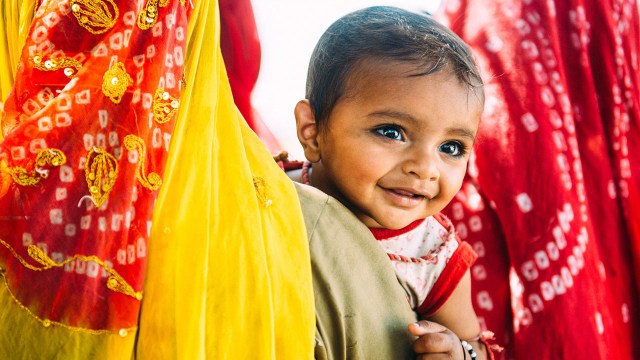
India is poised to become the world’s most populous country this year – surpassing China, which has held the distinction since at least 1950 , when the United Nations population records begin. The UN expects that India will overtake China in April , though it may have already reached this milestone since the UN estimates are projections.
Here are key facts about India’s population and its projected changes in the coming decades, based on Pew Research Center analyses of data from the UN and other sources.
This Pew Research Center analysis is primarily based on the World Population Prospects 2022 report by the United Nations. The estimates produced by the UN are based on “all available sources of data on population size and levels of fertility, mortality and international migration.”
Population sizes over time come from India’s decennial census. The census has collected detailed information on India’s inhabitants, including on religion, since 1881. Data on fertility and how it is related to factors like education levels and place of residence is from India’s National Family Health Survey (NFHS) . The NFHS is a large, nationally representative household survey with more extensive information about childbearing than the census. Data on migration is primarily from the United Nations Population Division .
Because future levels of fertility and mortality are inherently uncertain, the UN uses probabilistic methods to account for both the past experiences of a given country and the past experiences of other countries under similar conditions. The “medium scenario” projection is the median of many thousands of simulations. The “low” and “high” scenarios make different assumptions about fertility: In the high scenario, total fertility is 0.5 births above the total fertility in the medium scenario; in the low scenario, it is 0.5 births below the medium scenario.
Other sources of information for this analysis are available through the links included in the text.
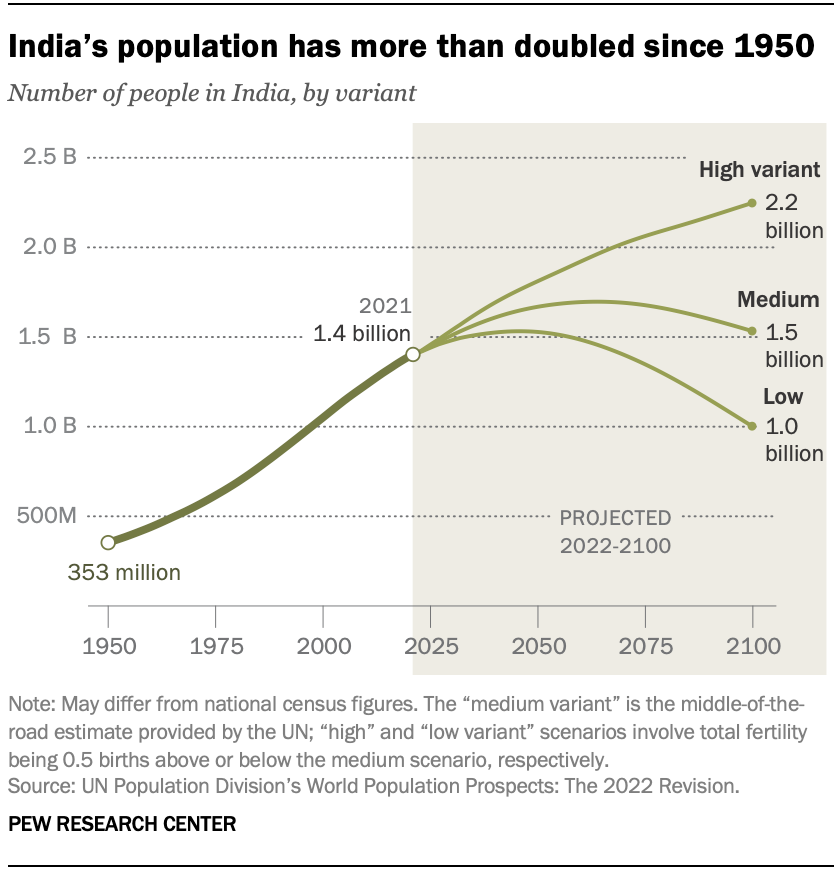
India’s population has grown by more than 1 billion people since 1950, the year the UN population data begins. The exact size of the country’s population is not easily known, given that India has not conducted a census since 2011 , but it is estimated to have more than 1.4 billion people – greater than the entire population of Europe (744 million) or the Americas (1.04 billion). China, too, has more than 1.4 billion people, but while China’s population is declining , India’s continues to grow. Under the UN’s “ medium variant ” projection, a middle-of-the-road estimate, India’s population will surpass 1.5 billion people by the end of this decade and will continue to slowly increase until 2064, when it will peak at 1.7 billion people. In the UN’s “high variant” scenario – in which the total fertility rate in India is projected to be 0.5 births per woman above that of the medium variant scenario – the country’s population would surpass 2 billion people by 2068. The UN’s “low variant” scenario – in which the total fertility rate is projected to be 0.5 births below that of the medium variant scenario – forecasts that India’s population will decline beginning in 2047 and fall to 1 billion people by 2100.
People under the age of 25 account for more than 40% of India’s population. In fact, there are so many Indians in this age group that roughly one-in-five people globally who are under the age of 25 live in India. Looking at India’s age distribution another way, the country’s median age is 28. By comparison, the median age is 38 in the United States and 39 in China.
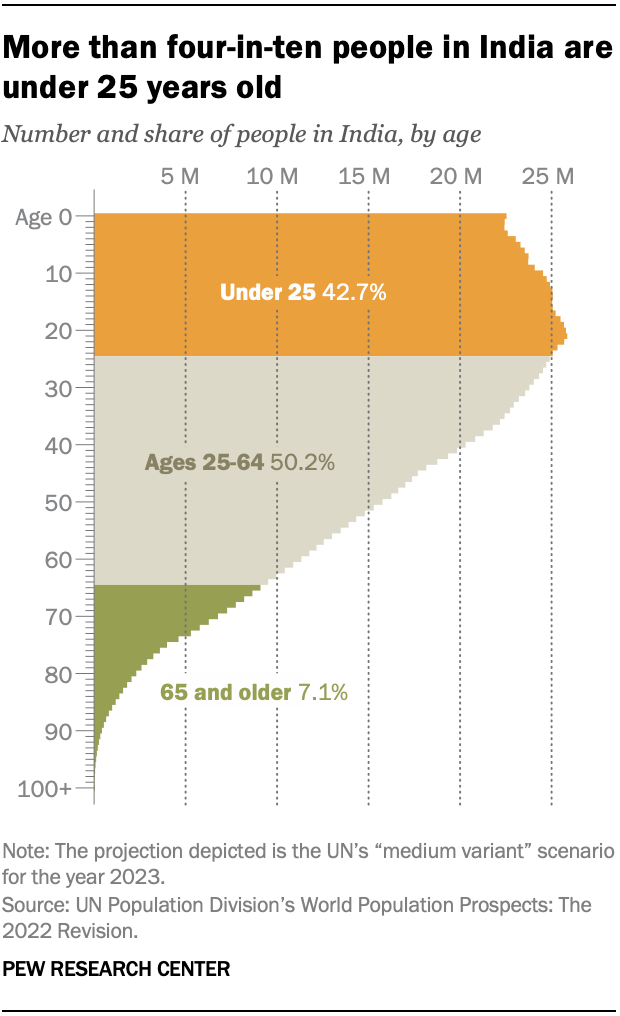
The other two most populous countries in the world, China and the U.S. , have rapidly aging populations – unlike India. Adults ages 65 and older comprise only 7% of India’s population as of this year, compared with 14% in China and 18% in the U.S., according to the UN. The share of Indians who are 65 and older is likely to remain under 20% until 2063 and will not approach 30% until 2100, under the UN’s medium variant projections.
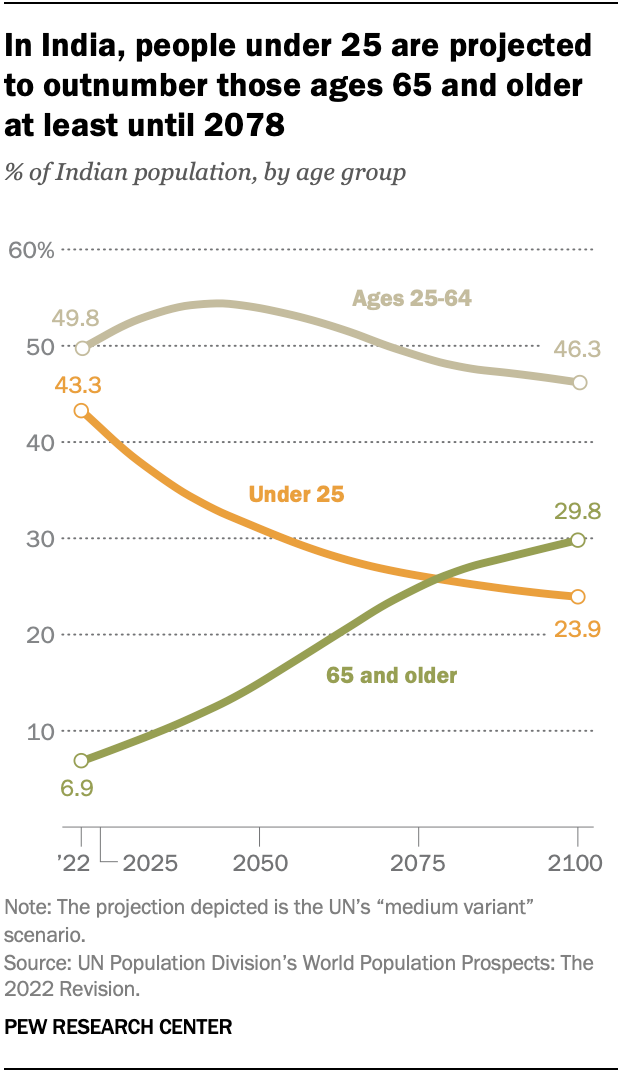
The fertility rate in India is higher than in China and the U.S., but it has declined rapidly in recent decades . Today, the average Indian woman is expected to have 2.0 children in her lifetime, a fertility rate that is higher than China’s (1.2) or the United States’ (1.6), but much lower than India’s in 1992 (3.4) or 1950 (5.9). Every religious group in the country has seen its fertility rate fall, including the majority Hindu population and the Muslim, Christian, Sikh, Buddhist and Jain minority groups. Among Indian Muslims, for example, the total fertility rate has declined dramatically from 4.4 children per woman in 1992 to 2.4 children in 2019, the most recent year for which data is available from India’s National Family Health Survey (NFHS). Muslims still have the highest fertility rate among India’s major religious groups, but the gaps in childbearing among India’s religious groups are generally much smaller than they used to be.
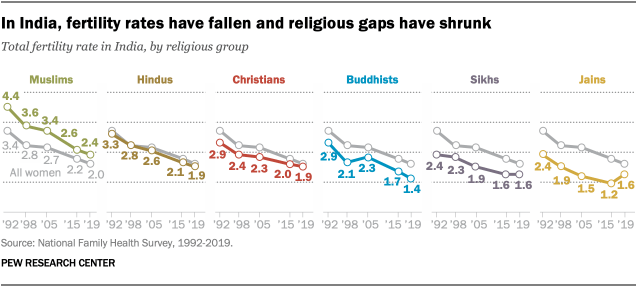
Fertility rates vary widely by community type and state in India. On average, women in rural areas have 2.1 children in their lifetimes, while women in urban areas have 1.6 children, according to the 2019-21 NFHS . Both numbers are lower than they were 20 years ago, when rural and urban women had an average of 3.7 and 2.7 children, respectively.
Total fertility rates also vary greatly by state in India , from as high as 2.98 in Bihar and 2.91 in Meghalaya to as low as 1.05 in Sikkim and 1.3 in Goa. Likewise, population growth varies across states. The populations of Meghalaya and Arunachal Pradesh both increased by 25% or more between 2001 and 2011, when the last Indian census was conducted. By comparison, the populations of Goa and Kerala increased by less than 10% during that span, while the population in Nagaland shrank by 0.6%. These differences may be linked to uneven economic opportunities and quality of life .
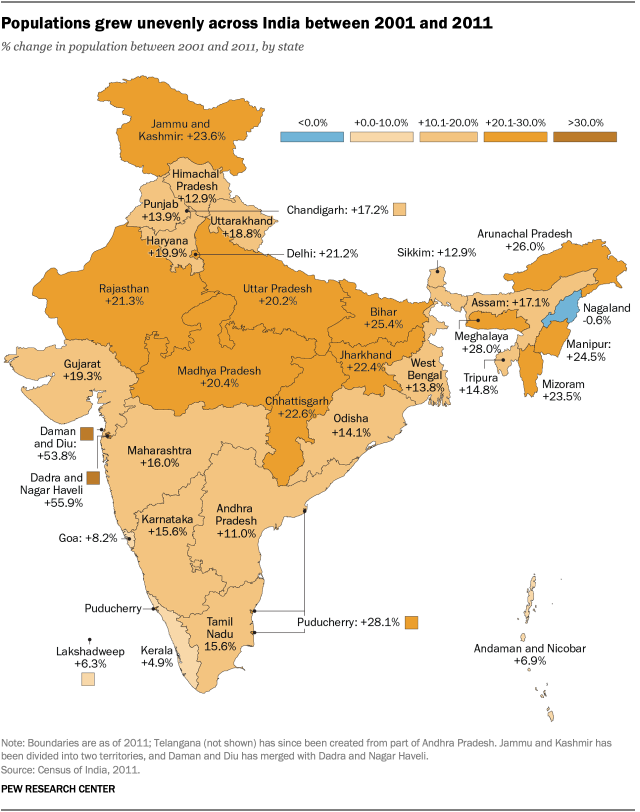
On average, Indian women in urban areas have their first child 1.5 years later than women in rural areas. Among Indian women ages 25 to 49 who live in urban areas, the median age at first birth is 22.3. Among similarly aged women in rural areas, it is 20.8, according to the 2019 NFHS.
Women with more education and more wealth also generally have children at later ages. The median age at first birth is 24.9 among Indian women with 12 or more years of schooling, compared with 19.9 among women with no schooling. Similarly, the median age at first birth is 23.2 for Indian women in the highest wealth quintile, compared with 20.3 among women in the lowest quintile.
Among India’s major religious groups, the median age of first birth is highest among Jains at 24.9 and lowest among Muslims at 20.8.
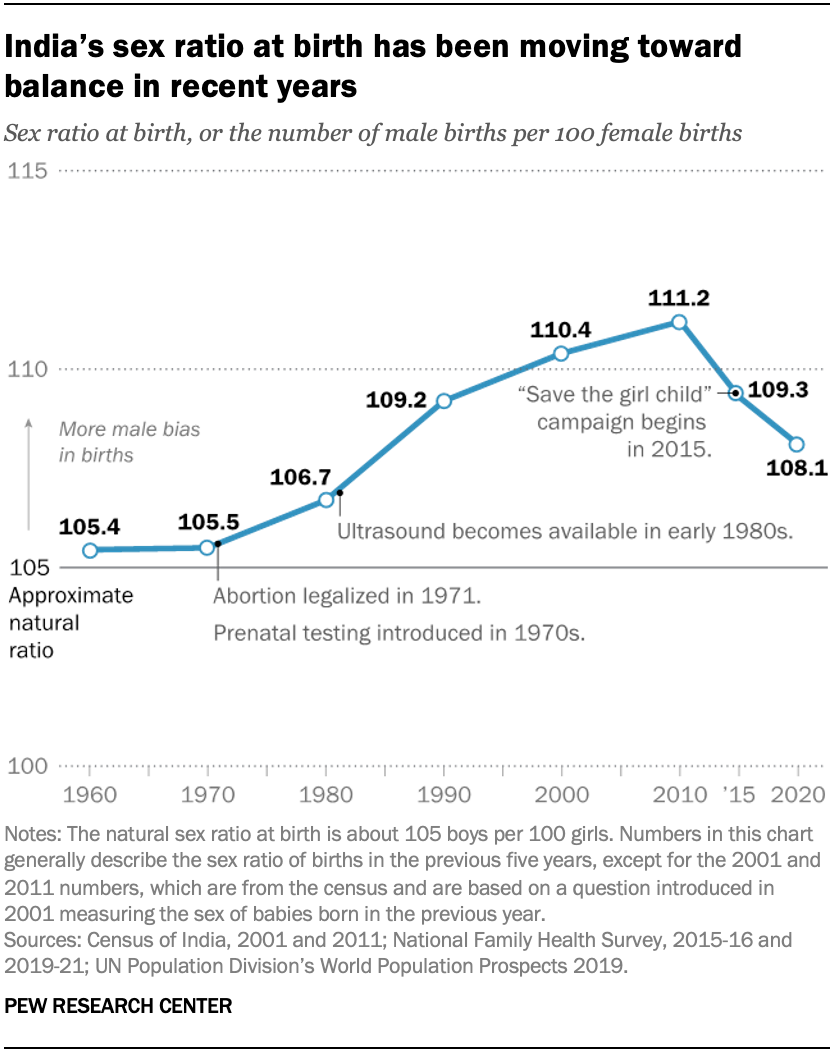
India’s artificially wide ratio of baby boys to baby girls – which arose in the 1970s from the use of prenatal diagnostic technology to facilitate sex-selective abortions – is narrowing. From a large imbalance of about 111 boys per 100 girls in India’s 2011 census, the sex ratio at birth appears to have normalized slightly over the last decade. It narrowed to about 109 boys per 100 girls in the 2015-16 NFHS and to 108 boys per 100 girls in the 2019-21 NFHS.
To put this recent decline into perspective, the average annual number of baby girls “missing” in India fell from about 480,000 in 2010 to 410,000 in 2019, according to a Pew Research Center study published in 2022 . (Read more about how this “missing” population share is defined and calculated in the “How did we count ‘missing’ girls?” box of the report.) And while India’s major religious groups once varied widely in their sex ratios at birth, today there are indications that these differences are shrinking.
Infant mortality in India has decreased 70% in the past three decades but remains high by regional and international standards. There were 89 deaths per 1,000 live births in 1990, a figure that fell to 27 deaths per 1,000 live births in 2020. Since 1960, when the UN Interagency Group for Child Mortality Estimation began compiling this data, the rate of infant deaths in India has dropped between 0.1% and 0.5% each year.
Still, India’s infant mortality rate is higher than those of neighboring Bangladesh (24 deaths per 1,000 live births), Nepal (24), Bhutan (23) and Sri Lanka (6) – and much higher than those of its closest peers in population size, China (6) and the U.S. (5).
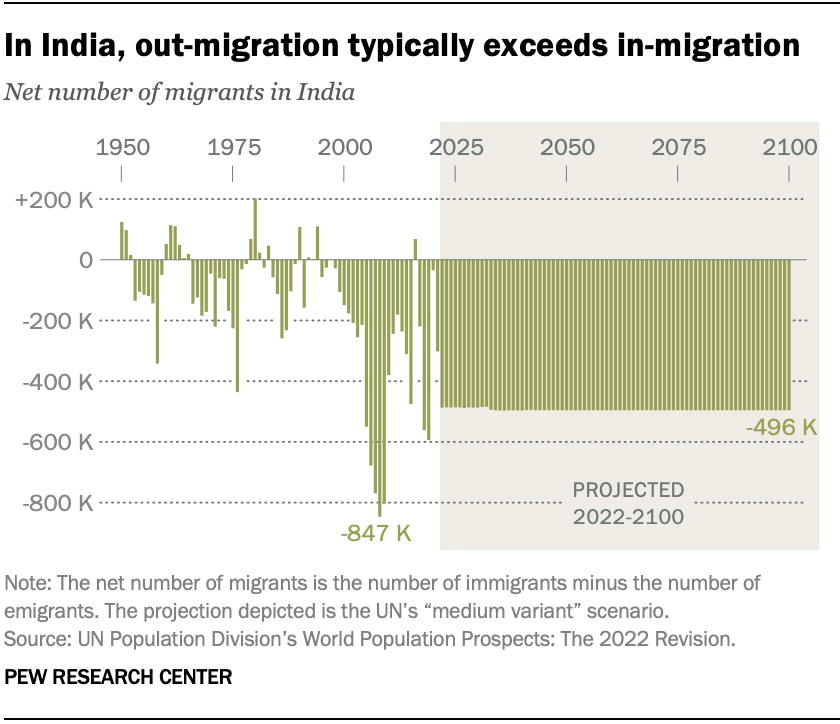
Typically, more people migrate out of India each year than into it, resulting in negative net migration. India lost about 300,000 people due to migration in 2021, according to the UN Population Division . The UN’s medium variant projections suggest India will continue to experience net negative migration through at least 2100.
But India’s net migration has not always been negative. As recently as 2016, India gained an estimated 68,000 people due to migration (likely to be a result of an increase in asylum-seeking Rohingya fleeing Myanmar). India also recorded increases in net migration on several occasions in the second half of the 20th century.
- Birth Rate & Fertility

Laura Silver is an associate director focusing on global attitudes at Pew Research Center .

Christine Huang is a research associate focusing on global attitudes at Pew Research Center .

Laura Clancy is a research analyst focusing on global attitudes research at Pew Research Center .
Few East Asian adults believe women have an obligation to society to have children
A growing share of americans say they’ve had fertility treatments or know someone who has, key facts about china’s declining population, global population skews male, but un projects parity between sexes by 2050, india’s sex ratio at birth begins to normalize, most popular.
1615 L St. NW, Suite 800 Washington, DC 20036 USA (+1) 202-419-4300 | Main (+1) 202-857-8562 | Fax (+1) 202-419-4372 | Media Inquiries
Research Topics
- Age & Generations
- Coronavirus (COVID-19)
- Economy & Work
- Family & Relationships
- Gender & LGBTQ
- Immigration & Migration
- International Affairs
- Internet & Technology
- Methodological Research
- News Habits & Media
- Non-U.S. Governments
- Other Topics
- Politics & Policy
- Race & Ethnicity
- Email Newsletters
ABOUT PEW RESEARCH CENTER Pew Research Center is a nonpartisan fact tank that informs the public about the issues, attitudes and trends shaping the world. It conducts public opinion polling, demographic research, media content analysis and other empirical social science research. Pew Research Center does not take policy positions. It is a subsidiary of The Pew Charitable Trusts .
Copyright 2024 Pew Research Center
Programs submenu
Regions submenu, topics submenu, press briefing: kenyan state visit, the challenge of financing global health, operations in the red sea: lessons for surface warfare, cooperative approaches to counter-narcotics: perspectives from the director of national drug control policy.
- Abshire-Inamori Leadership Academy
- Aerospace Security Project
- Africa Program
- Americas Program
- Arleigh A. Burke Chair in Strategy
- Asia Maritime Transparency Initiative
- Asia Program
- Australia Chair
- Brzezinski Chair in Global Security and Geostrategy
- Brzezinski Institute on Geostrategy
- Chair in U.S.-India Policy Studies
- China Power Project
- Chinese Business and Economics
- Defending Democratic Institutions
- Defense-Industrial Initiatives Group
- Defense 360
- Defense Budget Analysis
- Diversity and Leadership in International Affairs Project
- Economics Program
- Emeritus Chair in Strategy
- Energy Security and Climate Change Program
- Europe, Russia, and Eurasia Program
- Freeman Chair in China Studies
- Futures Lab
- Geoeconomic Council of Advisers
- Global Food and Water Security Program
- Global Health Policy Center
- Hess Center for New Frontiers
- Human Rights Initiative
- Humanitarian Agenda
- Intelligence, National Security, and Technology Program
- International Security Program
- Japan Chair
- Kissinger Chair
- Korea Chair
- Langone Chair in American Leadership
- Middle East Program
- Missile Defense Project
- Project on Critical Minerals Security
- Project on Fragility and Mobility
- Project on Nuclear Issues
- Project on Prosperity and Development
- Project on Trade and Technology
- Renewing American Innovation Project
- Scholl Chair in International Business
- Smart Women, Smart Power
- Southeast Asia Program
- Stephenson Ocean Security Project
- Strategic Technologies Program
- Transnational Threats Project
- Wadhwani Center for AI and Advanced Technologies
- All Regions
- Australia, New Zealand & Pacific
- Middle East
- Russia and Eurasia
- American Innovation
- Civic Education
- Climate Change
- Cybersecurity
- Defense Budget and Acquisition
- Defense and Security
- Energy and Sustainability
- Food Security
- Gender and International Security
- Geopolitics
- Global Health
- Human Rights
- Humanitarian Assistance
- Intelligence
- International Development
- Maritime Issues and Oceans
- Missile Defense
- Nuclear Issues
- Transnational Threats
- Water Security
What India Becoming the World's Most Populous Country Means

Photo: INDRANIL MUKHERJEE/AFP/Getty Images
Commentary by Jennifer Dabbs Sciubba
Published April 28, 2023
Continued population growth in India and depopulation in China mean that India is now assuming the throne as the world’s most populous country. From population size alone, not much can be inferred about India’s future, but a deeper dive into its demographic dynamics shows that the country’s leaders need to move quickly to make the most of their favorable age structure and maximize the country’s opportunity for accelerated economic growth.
Today, India’s population of 1.428 billion is nearly four times larger than the 361 million counted just after Partition in the 1951 census . That’s the India most people know, the “population bomb” biologist Paul Ehrlich described in his famous (and problematic) tome about overpopulation after he visited India in the mid-1960s. Despite its overall growth, India’s population dynamics today are little like those Ehrlich described. The average number of children per woman was nearly 6 in the 1960s, but today the average is only 2, which is considered below replacement level (UN demographers put India’s replacement level at 2.19). That average masks some internal differences, but only five Indian states have a fertility rate above 2, and the highest is Bihar at just under 3.
India’s rapid fertility decline is emblematic of the global trend . As of 2022, half of the world's countries had below-replacement fertility rates; in 2000, just over one-third did.
India’s population will keep growing, but its age composition is shifting.
Decades of below-replacement fertility will set any country on the path toward shrinking, barring a large volume of immigration. China’s population has already begun to shrink but even with low fertility, India’s population grows by one million each month and it will be after mid-century before India begins to depopulate. That is because much of India’s growth is baked in from the past and driven by “population momentum,” which is the tendency of a population to keep growing even if fertility falls because the size of childbearing cohorts is relatively larger from when fertility was higher (more potential mothers). In fact, India’s population is so large that it will drive much of the expected increase in global population between now and mid-century. When the world hits 9 billion sometime around 2037, 1.6 billion people will be Indian.
But the age structure of India’s population is drastically changing. The India of 25 years from now is fairly certain. India’s median age will be about 33–34 years, up from 28 years today and 21 years in 1998. That’s an increase of 12 years over a 50-year timespan, and just a shade behind increases in the global median age. The people who will give birth between now and 2048 are already born and there is a good sense of their reproductive tendencies (Indian women say they want about 1.6 children on average, so fertility will likely continue to trend downward). Given the size of those childbearing cohorts, plus modest life expectancy increases so that there will be more older people in India, India’s population will add only 230 million over the next 25 years. This is significant, but India has added 430 million over the last 25 years, from a population of 1 billion in 1997. As we see from the following figures, India’s age structure is becoming “stovepiped” when viewed from a 50-year time span, similar to the age structure of world population as a whole. India will stay relatively young for a while, but the number of young people aging into India’s workforce peaked a few years ago. This may make future job creation easier.
India’s demographic dividend is not guaranteed.
With that demographic profile, India has the conditions to reap a demographic dividend —a boost in economic growth from higher proportions of people of working age—if the right government policies are in place, such as investments in human capital. As in China, India’s leaders saw slower population growth as a prerequisite for economic development. Unlike China, however, India has not made the same investments in human capital in order to achieve those goals. Literacy, particularly for women, and education trail and the country needs to step up investments in health, as shown by its high infant mortality rate . Altogether, this means India needs to make serious investments if it is to maximize a demographic dividend.
And India needs to hurry. Western states saw fertility decline because of economic development; India’s declines came from family planning programs. That means the pace of demographic change has been faster, and the window of opportunity in which India has to reap its demographic dividend is shorter. It will have taken 75 years for the 60-plus population to grow from 15 percent to 30 percent in Western Europe. The same shift will take India only 34 years.
India is still relatively rural, although Indian cities are steadily growing. Delhi has been one of the world’s fastest growing cities, but on the whole India’s urbanization has lagged compared to what is expected given India’s global prominence. The United Nations places India’s urbanization at only 33 percent—China’s urbanization, in contrast, is 65 percent. Urbanization has historically been a key indicator of economic potential because it concentrates services, ideas, and jobs, so India’s low urbanization places a ceiling on their economic growth. Using recent urban data, one spatial modeling study projected five key Indian cities to grow an average of 1.5 to 2 times in the next decade. India’s National Commission on Population expects to reach over 38 percent by the middle of next decade, but that is still quite low. So, India has high urban growth potential, but is far behind the curve.
There are really two Indias.
Due to differences in fertility rates and emigration rates between the north and south, India is both a young country and an aging one, a microcosm of the global demographic divide. India’s northern states struggle more with poor health and illiteracy, while in the south, Kerala is already finding it difficult to staff assisted living homes for the elderly. It is tough to set policy priorities when the county has to address two very different population issues at the same time.
There is also the India for men and the India for women. According to the World Bank , just 23 percent of Indian women perform paid work, compared with 37 percent in Bangladesh and 63 percent of women in China. In India, much of this work is in the informal economy, which puts women at greater risk for financial insecurity in old age. Indian women enroll in higher education at higher rates than Indian men but India’s economy remains male-dominated. For India to maximize economic growth, they need better alignment between skills and jobs.
Population dynamics will be central for India’s future.
India’s population dynamics lay the groundwork for its future, but there is no guarantee that slower growth and a higher median age will translate to strong economic growth. Likewise, there is no guarantee that slower growth will lead to a cleaner, more sustainable environment. If all goes as planned, the 1.4 billion and counting people in India will see rising standards of living over the coming decades. That means affordable and realistic options for consumption in India are imperative, and India can model this greener path for the younger and dynamic economies in Africa, like Ethiopia’s, which will be following them on this demographic path. Environmental goals can support economic goals, too, if they include investments in green labor markets and industries .
Jennifer D. Sciubba is senior associate (non-resident) with the Project on Fragility and Mobility at the Center for Strategic and International Studies in Washington, D.C., and a Scholar at the Wilson Center. She is the author of 8 Billion and Counting: How Sex, Death, and Migration Shape Our World.
Commentary is produced by the Center for Strategic and International Studies (CSIS), a private, tax-exempt institution focusing on international public policy issues. Its research is nonpartisan and nonproprietary. CSIS does not take specific policy positions. Accordingly, all views, positions, and conclusions expressed in this publication should be understood to be solely those of the author(s).
© 2024 by the Center for Strategic and International Studies. All rights reserved.

Jennifer Dabbs Sciubba
Programs & projects.
- Skip to primary navigation
- Skip to main content
- Skip to primary sidebar
UPSC Coaching, Study Materials, and Mock Exams
Enroll in ClearIAS UPSC Coaching Join Now Log In
Call us: +91-9605741000
Population and Associated Issues
Last updated on April 13, 2024 by ClearIAS Team
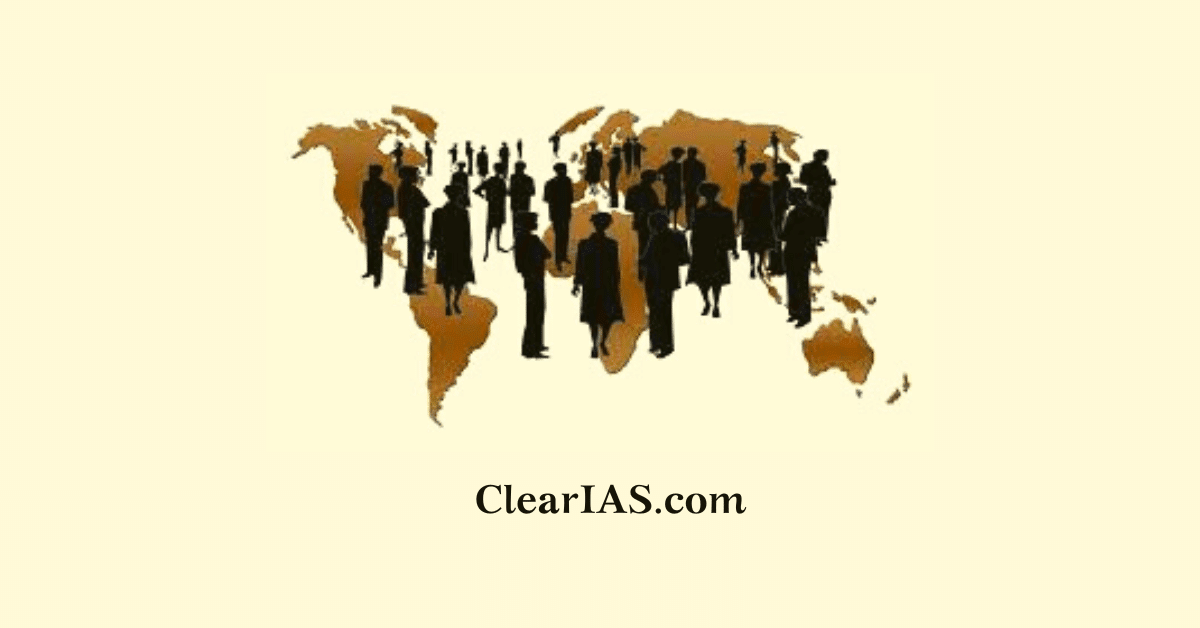
On November 15, 2022, the total number of humans living on the planet crossed 8 billion as per the data of the United Nations Population Fund 2022. What is India’s share of the world population? How does this population rise impact society? How can be effectively managed? Read on to know more.
According to World Population Prospects 2022 , India will overtake China as the world’s most populated nation in 2023.
In 1804, the number of people on earth reached one billion.
In 1930, it took an additional 126 years to reach the second billion, and a further 30 years to reach the third.
The fifth billion was completed in 13 years, whereas the fourth billion only required 14 years.
Table of Contents
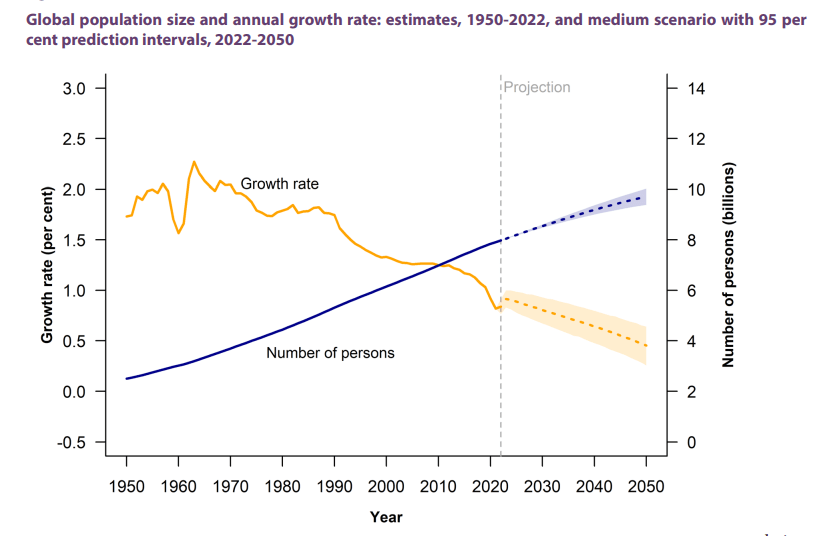
The rapid expansion of humans gives birth to numerous issues in the least developed regions.
Add IAS, IPS, or IFS to Your Name!
Your Effort. Our Expertise.
Join ClearIAS
It is suggested that immediate action needs to be taken to prevent population growth because failure to do so could result in major issues like environmental harm and a lack of food resources.
In a developing nation like India, the size and growth of the populace are two critical aspects of the demographic phenomenon. India is the second most populated nation in the world after China, with 1,412,495,893 people living there based on the latest United Nations data. India’s populace is equivalent to 7% of the world’s.
India ranks number 2 in the list of countries (and dependencies) by population.
India has overtaken China as the world’s most populous country, according to UN population estimates in April 2023.
Also read: China’s Population Decline
Findings related to India in UN World Population Prospects Report 2022
- India’s growth rate was 2.3% in 1972, while it is currently less than 1%.
- Over this time, the average number of children an Indian woman has in her lifetime has decreased from around 5.4 to under 2.1.
- The Replacement Fertility Rate, at which a population precisely replaces itself from one generation to the next, has reached India.
- With improved access to healthcare and medical developments, both fertility rates and mortality rates have been dropping.
- In the following decades, the population of 0-14 years, 15-24 years, and 65+ will continue to decrease while rising.
- Population expansion in India has been fueled by this decline in early mortality for succeeding generations, which is reflected in higher levels of life expectancy at birth.
What opportunities are brought about by a growing populace?
- First, a growing working-age population presents a chance for increased per-capita economic growth. The “ demographic dividend ,” a time-limited potential for rapid economic growth, is made possible by this change in the age distribution.
- Second, it contributes to the development of a consumption-driven economy that is less reliant on exports to survive. As observed in the example of India, such economies have the propensity to absorb global shocks in a substantially better manner.
- For international investors, the large domestic market is appealing. As a result, it contributes to drawing foreign investment into the domestic economy.
- Third, a growing population increases opportunities for immigration to other nations , which contributes to the creation of more foreign exchange reserves and strengthens a country’s soft power abroad.
- For instance, the Indian Diaspora in the U.S. sends a sizable share of remittances to their families who live in India.
Issues Related to Population Growth
Overpopulation is a severe threat to our existence. It results in issues with politics, society, and the economy, including unequal resource distribution, subpar living circumstances, a broken health system, and others.
UPSC Prelims Test Series 2024
Take All-India Mock Exams: Analyse Your Progress!
Overpopulation causes working institutions to become dysfunctional, undermines all efforts to upgrade the nation’s infrastructure, and makes social welfare programs ineffective.
Social Aspects
- Crime: Populace growth and poverty are directly related, and lack of resources and job prospects result in unemployment. The educated youth who are affected by unemployment are thus driven to commit social crimes like robbery, burglary, prostitution, murder, etc.
- The discontent among educated unemployed youth is reflected in the terrorist actions that we currently witness in several regions of the nation, for instance, Jammu and Kashmir.
- Minority-majority gap: Fears of supremacy over minorities and identity loss might arise in some cultures as a result of overpopulation.
- Thus, it has the potential to fuel communalism and cause rifts in the social fabric based on religion.
Economical Aspects
- Ageing population: Due to an increase in life expectancy, India’s population is ageing. This has increased the percentage of the elderly populace.
- for example, in 2011, Kerala’s share of the populace over 60 years old was 12.6% and Tamil Nadu’s was 10.4%. By 2031, these are anticipated to rise to 20.9% and 18.2%, respectively.
- An increase in the senior populace results in higher healthcare and social security costs. This will significantly increase the state exchequer’s financial burden and cut back on funding for investing in capital assets.
- Unemployment: Although there is a large army of labourers as a result of overpopulation, it is difficult to give each working person a job that pays a living wage due to a lack of capital resources.
- There is a clear distinction between disguised unemployment in rural areas and open unemployment in urban areas.
- Resource Depletion: Overpopulation is a direct cause of excessive resource exploitation, environmental degradation, and deterioration. While resources in India have either remained constant or have expanded arithmetically, generating resource constraints, population growth in India has been geometric.
- Uneven Income Distribution: The government’s need for investment and capital formation is impacted by overpopulation, which has an impact on the government’s overall development efforts.
- Unemployment, unequal food distribution, and rising poverty, which are the main causes of the increase in poverty, make the situation worse.
- Poverty: People become poor as a result of unemployment, unfair income distribution, and a lack of resources.
Political Aspects
- A nation’s politics is impacted by its economic and social conditions. Rising unemployment, poverty, and unequal wealth distribution all have an impact on the nation’s law and order condition.
- Caste politics: Political parties engage in caste-based politics to satisfy their vote bank, which is another factor contributing to the nation’s division.
- The interstate disparity in population distribution: There are significant differences between states in terms of growth and population. Increased migration into states with smaller populations and more established economies will be caused by rising populations in some states.
- Social conflict including the insider-versus-outsider debate may result from this. States already reserve jobs for their residents. Additionally, ageing States will depend on foreign immigrants to sustain economic growth.
Also read: Fertility Rate in India: Reasons for Decline
Environmental Aspects
- Environmental deterioration : Overpopulation is putting pressure on the land, and there is less land available per person.
- Environmental deterioration brought on by population growth includes pollution, biodiversity loss, and global warming, among other things. Cities like Delhi, which are suffering from air pollution, are already seeing the effects of overcrowding.
Health Aspects
- Spread of infectious diseases: One of the main elements affecting people’s health is population growth. Numerous infectious diseases have emerged as a result of concerns like urban overcrowding and environmental changes brought on by population growth.
- Governments are increasingly unable to expand their healthcare facilities and systems due to population increase.
Demographic Disaster
However, if the economic benefits are not inclusive, unable to create jobs, and unable to enhance the living conditions of the youth, the social cohesiveness may suffer significantly.
This optimistic view of the demographic dividend presented in the preceding discussion may be clouded by issues with education, employment prospects, and health care.
A youthful population that lacks skills is underutilized, and is frustrated might stymie economic development and cause a demographic disaster that could destabilize peace and incite conflict.
- The Pratham research states that just about 50% of fifth graders can read books from class two and struggle with basic addition and subtraction.
- Similarly to this, the health system is underdeveloped, and 48% of children are underweight now, contributing to the demographic dividend of the future.
- In eight industries over the last few years, India added the fewest new organized jobs than any other country. In 2017, the contribution from jobs in the unorganized sector increased to 93%, and 60% of those having jobs did not find work for the entire year, indicating persistent underemployment.
Therefore, the only way to prevent this demographic dividend from becoming a demographic disaster is to ensure that there is more employment in the manufacturing and service sectors, and we also need to work on revamping the educational system.
The negative consequences of low employment growth are already evident in the rise in violent protests, terrorism, and other law-and-order issues.
How Can the Population Rise be Effectively Managed?
- Raising the Marriage Age: Fertility is influenced by marriage age. Therefore, raising the marriage age to 21 is a good idea.
- Education dissemination: It influences people’s perspectives. It increases understanding of the significance of family planning and birth control options. Women who have received education are more health-conscious and steer clear of repeated pregnancies, which lowers the birth rate.
- Adoption: Adoption is another powerful tool for reducing the population. Despite costly medical care, some parents are unable to conceive. It is advised that they adopt children from orphanages.
- Economic Measures: Numerous economic actions must be implemented as preventative measures against population expansion. More employment opportunities must be created by the government through policies. It is essential to increase employment opportunities in both urban and rural locations.
India’s Population Policy
- India has had a formal population policy in place for more than 50 years.
- India may have been the first nation to formally declare such a policy in 1952.
- The National Family Planning Programme served as the implementation of the population policy. The fundamental goals of this programme have not changed much throughout the years; they are to attempt and change the rate and pattern of population growth in a socially desirable way.
- Early on, the main goals were to enhance public health standards, raise public knowledge of population and health issues, and cut down the rate of population growth by promoting various birth control methods.
- After the Emergency, the National Family Welfare Program was established instead of the National Family Planning Program, and coercive techniques were abandoned. A wide range of sociodemographic goals is now present for the programme.
- The National Population Policy of 2000 included the development of a fresh set of rules.
National Population Policy (NPP), 2000
The strategy sought to combine community initiative, women’s empowerment, education, and Panchayati Raj institutions into the field of population control. Family welfare is used in place of family planning.
Objectives:
- To provide integrated service delivery for essential reproductive and child health care , as well as to meet the unmet needs for contraceptives, health care infrastructure, and health professionals.
- By 2010, the total fertility rate should reach replacement levels as a medium-term goal.
- long-term goal: to stabilize the population by 2045.
Broad Targets:
- Reduce infant mortality to 30 per cent and improve child and reproductive health by addressing the infrastructure, service, and supply needs for basic reproductive and child health.
- Reduce the percentage of boys and girls who drop out of primary and secondary school to under 20% by making education up to the age of 14 free and mandatory.
- reduce maternal mortality to 100.
- Achieving universal immunization of children against all vaccine-preventable illnesses.
- Achieving 80% of deliveries should take place in medical facilities, 100% should be handled by skilled experts, and 100% of pregnancies, births, and deaths should be registered.
- It envisioned a stable population by 2045, which was later postponed to 2065.
- Enhancing the health and family welfare services and expanding access to contraceptives.
It has drawn criticism on several fronts since it offers monetary incentives for small family norms, even though financial incentives do not alter habits and behaviours based on social norms.
Additionally, NPP-2000 placed a strong emphasis on the function of Panchayati Raj Institutions, although it did not specify exactly what that function would be.
Disincentives are the most common kind of coercion. State-imposed disincentives frequently discriminate against the poor and women.
Government Schemes
To stabilize the population, the government has mostly relied on family planning initiatives. Family welfare programs are a crucial part of the family planning process, and several different ones have been introduced over time:
- The Janani Suraksha Yojana encourages institutional delivery while lowering maternal and newborn fatalities through financial aid.
- The Integrated Child Development Scheme emphasizes the overall health, nutrition, and vaccination of children under the age of six as well as the correct dietary and physical education of expectant and nursing mothers.
- program for universal immunization .
- Pradhan Swasthya Mantri The Suraksha Yojana aims to balance out the disparities between the cost and accessibility of tertiary-level healthcare.
- Program for ASHAs to provide contraceptives to beneficiaries’ homes and doorsteps.
- Plan for ASHAs to ensure birth spacing. An essential component of the ASHA kit now includes the pregnancy testing kit.
Population growth is a serious global concern that has negative socioeconomic, environmental, and health effects. The birth rate, mortality rate, and migration rates are all factors that affect the population growth rate of the country, which is rapidly rising. The demand for greater resources in overpopulated areas leads to deforestation for food production, urban overcrowding, and the spread of terrible diseases.
Since Independence, the government has launched several initiatives to reduce population increase, some of which have been somewhat successful in doing so. There is a need for a more targeted strategy in certain areas that continue to experience rapid population expansion.
Article Written By: Aryadevi E S

Aim IAS, IPS, or IFS?

Prelims cum Mains (PCM) GS Course: Target UPSC CSE 2025 (Online)
₹95000 ₹59000

Prelims cum Mains (PCM) GS Course: Target UPSC CSE 2026 (Online)
₹115000 ₹69000

Prelims cum Mains (PCM) GS Course: Target UPSC CSE 2027 (Online)
₹125000 ₹79000

About ClearIAS Team
ClearIAS is one of the most trusted learning platforms in India for UPSC preparation. Around 1 million aspirants learn from the ClearIAS every month.
Our courses and training methods are different from traditional coaching. We give special emphasis on smart work and personal mentorship. Many UPSC toppers thank ClearIAS for our role in their success.
Download the ClearIAS mobile apps now to supplement your self-study efforts with ClearIAS smart-study training.
Reader Interactions
Leave a reply cancel reply.
Your email address will not be published. Required fields are marked *
Don’t lose out without playing the right game!
Follow the ClearIAS Prelims cum Mains (PCM) Integrated Approach.
Join ClearIAS PCM Course Now
UPSC Online Preparation
- Union Public Service Commission (UPSC)
- Indian Administrative Service (IAS)
- Indian Police Service (IPS)
- IAS Exam Eligibility
- UPSC Free Study Materials
- UPSC Exam Guidance
- UPSC Prelims Test Series
- UPSC Syllabus
- UPSC Online
- UPSC Prelims
- UPSC Interview
- UPSC Toppers
- UPSC Previous Year Qns
- UPSC Age Calculator
- UPSC Calendar 2024
- About ClearIAS
- ClearIAS Programs
- ClearIAS Fee Structure
- IAS Coaching
- UPSC Coaching
- UPSC Online Coaching
- ClearIAS Blog
- Important Updates
- Announcements
- Book Review
- ClearIAS App
- Work with us
- Advertise with us
- Privacy Policy
- Terms and Conditions
- Talk to Your Mentor
Featured on

and many more...
IAS/IPS/IFS Online Coaching: Target CSE 2025
Are you struggling to finish the upsc cse syllabus without proper guidance, take clearias mock exams: analyse your progress.

Analyse Your Performance and Track Your All-India Ranking

Essay on Population Growth 500+ Words
India, a land of vibrant cultures and diverse landscapes, is also home to one of the world’s largest and fastest-growing populations. The topic of population growth in India is both a challenge and an opportunity. In this essay, I will argue that India’s population growth presents complex issues but also holds the potential for economic and social development.
The Magnitude of India’s Population Growth
India’s population has been steadily increasing for decades. It is currently the second-most populous country in the world, with over 1.3 billion people. The sheer magnitude of this growth raises questions about the country’s ability to provide essential services such as education, healthcare, and employment.
The Causes of Population Growth
Several factors contribute to India’s population growth. High birth rates, limited access to contraception in some areas, and cultural norms that favor larger families all play a role. Additionally, increased life expectancy has contributed to a growing elderly population.
The Challenges of Population Growth
One of the main challenges posed by rapid population growth is the strain on resources and infrastructure. India’s cities are experiencing overcrowding, traffic congestion, and a shortage of affordable housing. Healthcare facilities and schools are often stretched to their limits, impacting the quality of services.
Economic Opportunities
While population growth presents challenges, it also offers economic opportunities. A large and young workforce can be a valuable asset for a country’s development. India’s demographic dividend, with a significant proportion of young people, has the potential to drive economic growth, innovation, and entrepreneurship.
The Importance of Education
To harness the economic potential of its population, India must invest in education. Access to quality education for all is crucial for developing the skills and knowledge needed for a competitive job market. Improvements in the education system can empower individuals to contribute to the nation’s growth.
Healthcare and Family Planning
Addressing population growth also involves improving healthcare and family planning services. Access to affordable healthcare, reproductive health services, and contraceptives can help individuals make informed decisions about family size. Public awareness campaigns can promote smaller, healthier families.
Sustainable Development
India’s population growth is intrinsically linked to sustainable development. Balancing economic growth with environmental conservation is vital. Sustainable practices in agriculture, water management, and urban planning can mitigate the negative impact of a large population on resources and the environment.
Expert Opinions
Experts emphasize the need for a comprehensive approach to address India’s population growth. Investments in healthcare, education, and family planning are essential. Economist Amartya Sen has highlighted the importance of women’s empowerment and gender equality in reducing birth rates.
Conclusion of Essay on Population Growth
In conclusion, India’s population growth is a multifaceted issue that presents both challenges and opportunities. Managing this growth requires a concerted effort to improve healthcare, education, and family planning services. By harnessing its demographic dividend, India can promote economic growth and sustainable development while ensuring a better quality of life for its citizens. Balancing these aspects is the key to addressing the complex issue of population growth in India.
Also Check: Simple Guide on How To Write An Essay
Population Explosion Essay
500+ words population explosion essay.
Population explosion means a sudden increase in the number of individuals in a particular species. The term is used to refer to the world’s human population. In India, the Population explosion has become a severe matter of concern because the increase in population leads to poverty and illiteracy. In this situation, it is difficult to cope with the economy of the country with the rapid growth of the population. The Government of India is now looking into the matter seriously, and many states have framed laws to tackle the problem of population explosion.
Major Causes of Population Explosion
1. increase in birth rate.
One of the major causes for the growth of the population is the high birth rate. During the 1891-1990 period, the birth rate declined from 45.8 per thousand in India, but it is still considered high. So, unfortunately, in India, the birth rate has not seen a decrease in spite of the framing laws in terms of family planning, population education, campaigns, etc.

2. Decrease in Death Rate
In recent years, the decrease in the death rate has been another factor contributing to the rapid growth of the population. In 2001, the death rate in India was about 8.5 per thousand. The death rate has seen a decrease due to advancements in the medical field. For example, chronic diseases like typhoid, chickenpox, etc., are no longer dreaded. Even the infant mortality rate has decreased because of proper sanitation facilities, cleanliness, and better prenatal and postnatal care.
3. Early Marriage
Early marriage is also an essential factor in the rapid increase in population. In India, the marriage age of a girl is 18, which is very low compared to other countries, which is about 23 to 25 years. It leads to a longer span of reproductive activity.
4. Religious and Social Reasons
In India, marriage is considered a compulsory social institution, and every person should marry. Every individual in a joint family takes equal responsibility and has access to an equivalent level of consumption. So, people don’t hesitate to increase their family size to a joint family. In India, most people think that one male child is necessary, and in the expectation of getting a male child, they increase their family size.
Another major cause of the population explosion is poverty. In most families, children become the source of income. From a very young age, children start working for their families instead of going to school, and they become a precious asset to the family. So, every individual becomes an earning member and additional income for the family.
6. Standard of Living
It is seen that people with a low standard of living wish to have additional children as it will be an asset for them rather than a liability. As we know, most of India’s population is uneducated, so they don’t understand the importance of family planning. They are unaware that they can enjoy a better quality of life with a small family.
7. Illiteracy
In India, 60% of the population is either illiterate or has minimum education, which leads to minimal employment opportunities. So, due to the high illiteracy rate and belief in social customs, child marriage and preference for a male child still prevail. As a result, there is a rapid population growth rate in India.
Effects of Population Explosion
1. the problem of unemployment.
An increase in population leads to a vast army of the labour force. But, it is difficult to employ such extensive labour working force due to a shortage of capital resources. Disguised unemployment in rural areas and open unemployment in urban areas are fundamental features of an underdeveloped country like India.
2. More Pressure on Land
Overpopulation creates more pressure on land. It adversely affects the economic development of the country. On the one hand, per capita availability of land goes on diminishing and on the other, the problem of subdivision and fragmentation of holdings increases.
3. Environmental Degradation
Extensive use of natural resources and energy production of oil, natural gas, and coal negatively impacts the planet. An increase in population also leads to deforestation, which directly affects the environment, and it also degrades the soil’s nutritional value and causes landslides and global warming.
So, at last, we can wrap up the essay by stating that overpopulation is considered one of the biggest challenges humanity faces.
Students can also get different essays by visiting BYJU’S website. We have compiled a list of crucial CBSE Essays from an exam perspective.
Frequently Asked Questions on Population Explosion Essay
How can population explosion be controlled.
Awareness campaigns on childbirth control and the gap between consecutive children should reach the common public. It is necessary to take such initiatives to keep the population of a country in control.
Which country has the highest population?
China is a country with a maximum population of about 1.448 billion citizens.
How is the younger generation affected due to this population explosion?
The resources which are meant exclusively for the younger generation get split and are divided due to the population explosion of a country.
Leave a Comment Cancel reply
Your Mobile number and Email id will not be published. Required fields are marked *
Request OTP on Voice Call
Post My Comment
- Share Share
Register with BYJU'S & Download Free PDFs
Register with byju's & watch live videos.

Counselling
Talk to our experts
1800-120-456-456
- Population Explosion Essay

Essay on Population Explosion
After the Republic of China, India is the most populous country in the world. Presently, India is the second-largest populated country in the world that occupies 2.4% of the world’s land area and represents 17.5% of the world’s population. This means that one out of six people on this planet is an Indian.
It is estimated by the United Nations that India with 1.3 billion inhabitants would surpass China’s population of 1.4 billion by 2024 to become the world’s most populous country. Population Explosion is considered as a threat and burden on the Earth.
What is Population Explosion?
Population Explosion refers to the rapid increase in the number of people in an area. It is a situation where the economy of the country cannot cope up with the rapid growth of the population. Furthermore, in simpler words, it is a situation where the economy cannot provide proper facilities to its people.
Evidently, the largest contributing countries to population explosion are the poorer nations and are termed as developing countries. In India, the state of Uttar Pradesh is the most populated state and Lakshadweep is the least populated. Hence we can say that population explosion is inversely related to the development of that area.
Population Explosion has become the mother of evils in our country because too much population is trapping people in a web of poverty and illiteracy that further escalates the problem. Any time of the day, whether it is a metro station, airport, railway platforms, road, highway bus stop, shopping mall, market, or even a social or religious gathering, there is always a swelling crowd of people in India.
Causes of Population Explosion
The major cause of this population explosion is the difference between the birth rate. The birth rate is the number of individuals born in a population in a given amount of time. The human birth rate is the number of individuals born per year per 1000 in the population. For example, if 35 births occur per year per 1000 individuals, the birth rate is 35 ) .
The death rate is the ratio between deaths and individuals in a particular population during a particular period. In simple words, the incidence of deaths in a given population during a defined time (such as one year) is expressed per 1000 individuals ).
Apart from these, some other factors are partially responsible for population explosion, such as:
A decrease in infant mortality rate (Mortality rate refers to the number of deaths of infants below the age of 6 months.),
The increase in life expectancy (An estimate of the average number of additional years that a person of a given age can expect to live).
Earlier the life expectancy of people was around 55-60 years. Now the average age of a person has increased to 70-75 years.) but due to better and improved medical facilities, we can now increase the life expectancy of people.
Earlier, there was a balance between the birth and death rate due to limited medical facilities, people dying in wars, and other calamities. According to the 2011 census, the birth rate has actually come down but then the death rate has also declined due to the medical advancements.
Illiteracy is another cause of an increase in population. Low literacy rate leads to traditional, superstitious, and ignorant people. For example, Kerala has a very high literacy rate and it constitutes only 2.76% of India’s population as compared to Uttar Pradesh having maximum illiteracy rate and forms 16.49% of the population. Educated people are well aware of birth control methods.
Family planning, welfare programs, and policies have not fetched the desired result. The increase in population is putting tremendous pressure on the limited infrastructure and negating India’s progress.
The superstitious people mainly from rural places think that having a male child would give them prosperity and so there is a considerable pressure on the parents to produce children till a male child is born. This leads to a population explosion.
Poverty is another main reason for this. Poor people believe that the more people in the family, the more will be the number of persons to earn bread. Hence it contributes to the increase in population.
Continuous illegal migration of people from neighbouring countries like Nepal, Bangladesh is leading to a rise in the population density in India.
Religion sentiment is another cause of the population explosion. Some orthodox communities believe that any mandate or statutory method of prohibition is sacrilegious. It is difficult for India to exercise a check on the religious grounds for its secularism.
Impact Due to Population Explosion
The growth of the population has a major impact on the living standards of people. That is why, despite our incredible progress in the agricultural and industrial spheres, our capita income has not risen appreciably.
Hence given below are some of the major problems which are just because of the population explosion:
Natural Resources of that particular region: Natural resources are materials from the Earth used to support life and meet people’s needs. Hence if there are many people, then there is a high requirement for Natural Resources.
Unemployment: When a country becomes overpopulated, it gives rise to unemployment as fewer jobs support many people. The rise in unemployment gives rise to crime, such as theft, as people want to feed their families and provide them with basic amenities of life.
High Cost of Living: As the difference between demand and supply continues to expand due to population explosion, it raises the prices of various essential commodities, including food, shelter, and healthcare. It means that people have to pay more to survive and feed their families.
Poverty: Another major issue of population explosion is the increase in poverty as people are unemployed due to a lack of job opportunities and an abundant workforce.
Illiteracy: Because of unemployment, they cannot provide better education to the coming generation, giving us back population explosion.
Starvation: When resources are scarce, starvation, ill health, and diseases caused by diet deficiency such as rickets become eminent.
Some Major Effects of the High Population are as Follows
The rapidly growing population in India has led to the problem of food scarcity and heavy pressure on land. Even though 60% of its population is engaged in agriculture, yet people do not get even the barely necessary amount of food.
Generating employment opportunities for such a huge population in India is very difficult. Therefore, illiteracy is growing rapidly every year.
Development of infrastructural facilities is not able to cope up with the pace of growing population. So facilities like transportation, communication, housing, education, and healthcare are becoming inadequate to provide provision to the people.
The increasing population leads to unequal distribution of income and inequalities among the people widened.
Unmanageable population size may lead to the failure of the government to provide the basic facilities to the people.
Economic development is slow in a country where the population is growing at a very fast rate. This also leads to low capital formation.
Ignorance, illiteracy, unhygienic living conditions, and lack of recreation have always been the cause of population problems in India.
Rapid growth in population is also an indication of the wastage of natural resources.
Preventive Measures
To tackle this problem, the government needs to take corrective measures. The entire development of the country depends on how effectively the population explosion is stemmed.
The government and various NGOs should raise awareness about family planning and welfare. Hoardings with slogans like “Hum do, humare do” and “Chota Parivar, Sukhi Parivar” should be put up in hospitals and other public places. These slogans mean that a small family is a happy family and two children for two parents. The awareness about the use of contraceptive pills and family planning methods should be generated.
The health care centres should help the poor people with the free distribution of contraceptives and encourage the control of the number of children.
The government should come forward to empower women and improve the status of women and girls. People in rural places should be educated and modern amenities should be provided for recreation.
So we can summarise the topic by stating that population explosion is a term used to state the rapid growth of people in a particular area. It is because of lack of education, illiteracy, lack of proper knowledge of sex education, rituals, and superstition in the country’s most populated area.
Overpopulation results in a lack of development and exploitation of resources, whereas India’s strength in the global world in various fields cannot be ignored. By raising public awareness and enlisting strict population control norms, India will be able to tackle this issue.
It doesn’t mean that will happen very quickly and without any effort. It will take time because India constitutes one of the huge countries of about 138 Crore (2020) people. Proper, effective, and steady steps will lead India to a greater good.
It helps the country control the population explosion and also helps to provide good results in several other things like the good environment, abundant natural resources, proper employment, proper literacy rate with high growth in development, etc.
All this could be possible if we take some measures and be good citizens of this country. So that is how we can overcome this issue of population explosion.

FAQs on Population Explosion Essay
1) What is Population Explosion?
Population Explosion refers to a rapid increase in people in a particular area. Occurring due to reasons like increased birth in the area, decreased mortality rate, and inflow of residents, population explosion may lead to shortage of resources, negatively affecting the development of the area.
2) How is the birth rate related to population explosion?
Birth rate is directly proportional to population explosion because of people’s lack of knowledge and literacy. Most common in poor families, where more children means more means of income, increased birth rate gradually results in a population explosion.
3) What are the measures to avoid population explosion?
Better education (specially for girl child), creating awareness of family planning, providing proper knowledge of Sex Education, etc. can be some solutions to tackle the issue.
4) What is the difference between death rate and infant mortality rate?
The ratio between deaths and individuals in a particular population during a particular period is the death rate, whereas the infant mortality rate refers to the number of infants below 6 months who died within the same period.
5) What are the major reasons for the population explosion?
The major factors responsible for population explosion are illiteracy, reduced mortality, increased birth rate, and life expectancy.

Essay on Population Growth in India
Students are often asked to write an essay on Population Growth in India in their schools and colleges. And if you’re also looking for the same, we have created 100-word, 250-word, and 500-word essays on the topic.
Let’s take a look…
100 Words Essay on Population Growth in India
Introduction.
India, the second most populous country globally, has seen significant population growth over the years. This growth has both benefits and challenges.
Causes of Growth
Several factors contribute to India’s population growth, including high birth rates, declining mortality rates, and increased life expectancy due to medical advancements.
Impacts of Growth
Population growth affects various aspects of society. It can strain resources, increase unemployment, and exacerbate poverty. However, it also provides a large workforce, boosting economic growth.
In conclusion, while population growth presents certain challenges, effective planning and policy-making can turn it into an asset for the nation.
250 Words Essay on Population Growth in India
India, the second most populous country in the world, is experiencing explosive population growth. This growth, while indicative of improved health services, has significant repercussions on the country’s socio-economic fabric.
Causes of Population Growth
The primary cause of this surge is a decrease in mortality rates due to advancements in medical sciences and an increase in birth rates. Socio-cultural factors such as the preference for a male child, leading to larger families, also contribute.
Impacts of Population Growth
The burgeoning population exerts immense pressure on India’s limited resources, leading to issues like unemployment, poverty, and inadequate public health and education services. It also poses a severe threat to the environment due to overexploitation of natural resources.
Population Control Measures
India has implemented various population control measures like family planning and awareness programs. However, their effectiveness is often limited by socio-cultural barriers and lack of access to resources in rural areas.
While population growth signifies a healthy populace, it is imperative for India to check this growth to prevent socio-economic and environmental crises. This requires comprehensive strategies that address not just the symptoms but the root causes of population growth, including societal norms and access to resources.
500 Words Essay on Population Growth in India
India, the second most populous country in the world, is experiencing significant population growth. With over 1.3 billion people, the demographic changes in India are influencing its social, economic, and environmental dynamics. This essay explores the causes, implications, and potential solutions to the population growth in India.
The primary cause of India’s population growth is the decline in death rates. With advancements in healthcare and technology, life expectancy has improved, leading to a larger ageing population. Furthermore, despite efforts to promote family planning, the fertility rate remains high in many regions, particularly in rural areas. This is due to a lack of education, socio-cultural norms, and limited access to contraception.
Implications of Population Growth
The population surge in India brings both challenges and opportunities. On one side, it places immense pressure on resources such as water, food, and land. Rapid urbanization and the subsequent strain on infrastructure, including housing, sanitation, and transportation, are notable issues. Additionally, it exacerbates environmental degradation and climate change.
On the other hand, a large population signifies a vast labor force, which, if harnessed correctly, could propel economic growth. However, this demographic dividend can only be realized if the population is healthy, educated, and skilled, which is a challenge in itself given the current state of India’s public services.
In response to the population growth, the Indian government has implemented several measures. Family planning programs, awareness campaigns about contraception, and efforts to improve women’s education and empowerment have been at the forefront. However, these initiatives have not been uniformly successful across the country.
The Way Forward
Addressing population growth requires a multifaceted approach. Firstly, it is essential to improve the quality of education and healthcare, particularly in rural and marginalized areas. This includes comprehensive sex education and easy access to contraception to enable informed family planning decisions.
Secondly, empowering women through education and employment opportunities is crucial. Women who are educated and economically independent tend to have fewer children and invest more in their wellbeing, contributing to a decline in population growth.
Finally, it is vital to foster sustainable development and resource management to mitigate the environmental impact of population growth. This includes promoting green technologies, sustainable agriculture, and efficient use of water and energy.
India’s population growth is a complex issue with deep-rooted socio-cultural, economic, and environmental implications. While it presents significant challenges, it also offers opportunities if managed effectively. A combination of education, healthcare improvement, women’s empowerment, and sustainable development can help India navigate its demographic transition and harness its potential demographic dividend.
That’s it! I hope the essay helped you.
If you’re looking for more, here are essays on other interesting topics:
- Essay on National Festivals of India
- Essay on My India My Pride
- Essay on Life in an Indian Village
Apart from these, you can look at all the essays by clicking here .
Happy studying!
Leave a Reply Cancel reply
Your email address will not be published. Required fields are marked *
Save my name, email, and website in this browser for the next time I comment.

Essay on Population in India | Population issue in India | Essays for All Age Groups | Short and Long
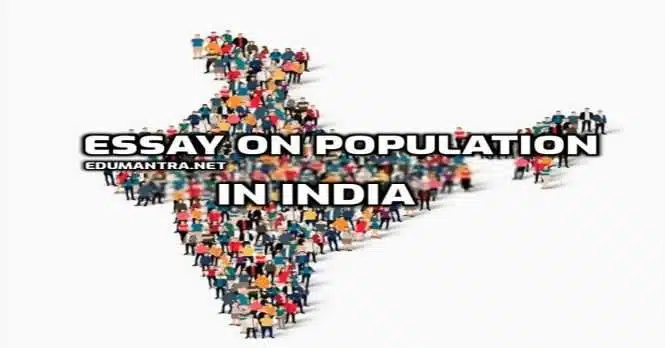
The population issue in India is multifaceted, with both challenges and opportunities. This collection of essay on population in India offers insights into the current population of India , its growth trends, and the myriad implications. These essays cater to readers of all age groups, providing a comprehensive understanding of the population dynamics in the country.”
Table of Contents
Population issue in india : essay on population in india 100 words.
The population issue in India is a topic of significant concern for all. The government is struggling to keep up with the demand for services and infrastructure. The situation is made worse by the fact that many people live in poverty and do not have access to basic needs like healthcare and education. The population problem is compounded by the fact that India has a young population.
This means that there will be more people entering the workforce in the coming years, putting even more strain on the already overloaded system. Let’s get more educated and try to understand that increase in pollution can be a major issue of concern.
Essay on Population in India- 150 Words
The population issue in India becomes evident when considering that the country has a population surpassing 1.4 billion, indicating the magnitude of the population issue of India. This makes India the second most populous country in the world, after China. The population of India is expected to continue to grow in the coming years, reaching around 1.5 billion by 2050.
India has a relatively young population, with around 64% of the population under the age of 35. As the population of India continues to grow, it’s important to consider the implications this will have on the country. More people mean more strain on resources like food and water.
There will also be more competition for jobs, and housing may become more cramped and expensive. On the other hand, a larger population also brings with it more diversity and creativity. It will be interesting to see how India adapts as its population grows in the coming years. Additionally, the government will need to create policies that address issues like overpopulation and poverty.
Population Issue in India: 200 Words Essay on Population
The population of India is currently over 1.3 billion. This number is expected to grow to 1.7 billion by 2050. India is the second most populous country in the world, behind only China. The population growth rate in India is about 1.2% per year. The high population density in some areas of the country, combined with the large number of people living in poverty, creates challenges for the government in terms of providing adequate services and infrastructure.
While this may not seem like much, it means that the population of India is growing by about 15 million people every year. This rapid growth is causing problems for the country, as it struggles to provide enough resources for its citizens. India’s government has been trying to implement policies to control the population growth, but so far they have not been very successful.
The high population growth rate is due to a combination of factors, such as a young population, high birth rates, and low death rates. The population density in India is about 464 people per square kilometer (1,200 per square mile). It is too much. This condition may get worsen if the needed steps are not taken. I urge everyone to think more practically and follow the knowledge regarding population control.
Essay on Population in India- 300 Words
The population issue in India is evident as the numbers continue to grow rapidly, and is expected to overtake China as the world’s most populous country by 2027. The population growth in India is a major concern, as the country faces significant challenges in providing adequate resources and infrastructure for its people.
Overcrowding is a major problem in many parts of the country, and this is likely to only get worse as the population continues to grow. The majority of the population is under the age of 35, and the median age is 28. This means that India has a large potential workforce that can drive economic growth.
However, the country also faces challenges due to its population size. Overcrowding is a major problem in many parts of India, and this can lead to poor sanitation and a lack of access to basic services. The government is working on initiatives to control population growth, but it will be a long and difficult process. it’s no surprise that population growth is a big issue in India.
The government has been trying to control population growth for years, but it’s a difficult task. There are many factors that contribute to population growth, including poverty, lack of access to contraception, and cultural norms. In spite of the challenges, the government has made some progress in recent years.
The total fertility rate (the number of children a woman is expected to have in her lifetime) has declined from 3.6 in 2000 to 2.3 in 2016. However, more needs to be done to keep population growth under control. Otherwise, India will continue to struggle with overcrowding, economic inequality, and environmental degradation.
The population is growing at an alarming rate and it is estimated that by 2030, India will be the most populous country in the world. The main reason for this population growth is because of the high birth rate. In India, there are more than 30 births per 1,000 people. This is much higher than the global average of 20 births per 1,000 people. The high birth rate is due to the lack of family planning and the high prevalence of child marriages.
We should understand that overpopulation leads to poverty, poor sanitation, and environmental degradation. Thus it is our duty to be more responsible and think wisely so that we can limit the use of resources and save them for the coming generations.
Population Issue in India: Essay on Population in India- 400 + Words
Introduction
Understanding the population of India requires a nuanced approach, considering the diverse factors influencing its growth. However, current projections estimate that the world’s population will reach 9.7 billion by 2050, and it is projected to continue to grow to 11.2 billion by 2100. This growth is largely due to increases in life expectancy and fertility rates in developing countries. As the world’s population continues to grow, it is important to consider the impact this will have on our planet’s resources. We must find ways to increase food production, provide clean water and sanitation, and conserve energy and other natural resources. Additionally, we must find ways to reduce greenhouse gas emissions and combat climate change.
India’s population growth
India’s population growth is a controversial issue. Some people believe that India’s population is growing too rapidly and is a strain on resources, while others believe that the population growth is necessary for the country’s economic development.
The Current Population of India
The current population of India is around 1.3 billion people, making it the second most populous country in the world after China. India is expected to become the world’s most populous country by 2027, and will likely remain so for the rest of the 21st century. The high rate of population growth in India is largely due to the country’s young population, with over 60% of the population being under the age of 25. The vast majority of India’s population is Hindu (80%), followed by Muslims (14%) and Christians (2%).
How Population has Grown in India over the Years
The population of India has grown steadily over the years, from around 550 million in 1951 to over 1.2 billion in 2011. The rate of growth has slowed down in recent years, but the absolute numbers continue to increase. This is due to a number of factors, including improved medical care and advances in contraception. There are a number of challenges that come with such a large population. India is currently the second most populous country in the world, and is projected to overtake China as the most populous country sometime in the next decade. This means that there is a lot of pressure on resources, and on infrastructure. There are also issues with employment, as there are not enough jobs to go around. The government is aware of these challenges, and is working on strategies to address them. For example, the government has launched programs to improve employment opportunities, and to provide better access to healthcare and education. It is also working on increasing agricultural productivity, so that more food can be produced to meet the needs of the growing population. There is no easy solution to the challenges posed by India’s large population. But with careful planning and implementation, it is possible to make sure that everyone has access to the resources they need,
The consequences of overpopulation in India
The population of India is currently over 1.3 billion and is projected to continue to grow. This rapid population growth has led to many consequences, both positive and negative.
On the positive side, India’s economy has been growing rapidly in recent years, thanks in part to the large number of people of working age. This has led to increased opportunities for employment and economic advancement.
However, the negative consequences of overpopulation are also evident. India faces significant challenges in providing adequate housing, healthcare, education and other basic services to its huge population. Overcrowding is a major problem in many parts of the country, which can lead to poor sanitation and an increased risk of disease. Competition for jobs is also intense, which can result in low wages and poor working conditions.
Steps taken by the Government to control Population Growth in India
There are many steps that the Indian government has taken in order to control population growth. Some of these steps include: 1. Encouraging late marriages: The government has been promoting the concept of late marriages in order to reduce the number of births each year. This is because most couples who marry later in life tend to have fewer children. 2. Providing financial incentives: The government has also been providing financial incentives to couples who opt for smaller families. This is done in order to encourage people to have fewer children. 3. Improving access to contraception: The government has been working on improving access to contraception, so that people can better control their fertility. This includes making condoms and other forms of birth control more readily available, as well as providing sex education in schools. 4. Investing in health care: The government has been investing in health care, so that more women have access to quality prenatal and postnatal care. This is important because it helps improve the health of both mother and child, and can help reduce the number of infant and maternal deaths. 5. Promoting gender equality: The government has been promoting gender equality, so that women have the same opportunities as men
Do these measures work?
There is no one answer to this question. India’s population is growing at an alarming rate, and the government has taken several measures to try to control it. Some of these measures have been successful, while others have not been as effective. One of the most successful measures has been the introduction of the two-child policy, which has helped to reduce the fertility rate in India. However, other measures, such as the forced sterilization program, have not been as successful and have been widely criticized.
The Problems caused by overpopulation in India
There are many problems caused by overpopulation in India. One of the most serious problems is the shortage of food and water. With so many people living in one area, there is not enough food or water to go around. This can lead to starvation and dehydration, which can be deadly. Another problem caused by overpopulation is pollution. With so many people living in close quarters, the air can become polluted very quickly. This can cause respiratory problems and other health issues. Overpopulation can also lead to crime. When there are too many people living in an area, it can be difficult for the police to keep everyone safe. This can lead to an increase in crime rates, which can make an area very dangerous to live in. Finally, overpopulation can cause social unrest. When people are overcrowded, they can become stressed and frustrated. This can lead to riots and other forms of violence.
Solutions to the problem of overpopulation in India
There are many ways to solve the problem of overpopulation in India. Some of these solutions include:
1. Increasing the availability of family planning services: Family planning services help couples to plan and space their children, which can help to reduce the rate of population growth . 2. Improving maternal and child health: Ensuring that women and children have access to good quality health care can help to reduce the number of infant and child deaths, and also improve the health of mothers. 3. Investing in education: Educating girls and boys can help to empower them and give them the tools they need to make informed decisions about their reproductive health. 4. Creating opportunities for economic empowerment : When women are economically empowered, they are more likely to delay marriage and childbearing, and have fewer children overall. 5. Addressing environmental concerns: India’s growing population is putting strain on the country’s resources, so it is important to address environmental concerns such as deforestation, water scarcity, and air pollution.
In conclusion, India’s population is a source of both strength and weakness. On the one hand, the large number of people living in India gives the country a significant competitive advantage in terms of labor and market size. On the other hand, India’s population also presents a number of challenges, including overcrowding, poverty, and environmental degradation. The key to managing India’s population effectively will be to find a balance between these two extremes.
Related Posts
- CBSE Class 10th
- CBSE Class 12th
- UP Board 10th
- UP Board 12th
- Bihar Board 10th
- Bihar Board 12th
- Top Schools in India
- Top Schools in Delhi
- Top Schools in Mumbai
- Top Schools in Chennai
- Top Schools in Hyderabad
- Top Schools in Kolkata
- Top Schools in Pune
- Top Schools in Bangalore
Products & Resources
- JEE Main Knockout April
- Free Sample Papers
- Free Ebooks
- NCERT Notes
- NCERT Syllabus
- NCERT Books
- RD Sharma Solutions
- Navodaya Vidyalaya Admission 2024-25
- NCERT Solutions
- NCERT Solutions for Class 12
- NCERT Solutions for Class 11
- NCERT solutions for Class 10
- NCERT solutions for Class 9
- NCERT solutions for Class 8
- NCERT Solutions for Class 7
- JEE Main 2024
- MHT CET 2024
- JEE Advanced 2024
- BITSAT 2024
- View All Engineering Exams
- Colleges Accepting B.Tech Applications
- Top Engineering Colleges in India
- Engineering Colleges in India
- Engineering Colleges in Tamil Nadu
- Engineering Colleges Accepting JEE Main
- Top IITs in India
- Top NITs in India
- Top IIITs in India
- JEE Main College Predictor
- JEE Main Rank Predictor
- MHT CET College Predictor
- AP EAMCET College Predictor
- GATE College Predictor
- KCET College Predictor
- JEE Advanced College Predictor
- View All College Predictors
- JEE Main Question Paper
- JEE Main Cutoff
- JEE Main Advanced Admit Card
- AP EAPCET Hall Ticket
- Download E-Books and Sample Papers
- Compare Colleges
- B.Tech College Applications
- KCET Result
- MAH MBA CET Exam
- View All Management Exams
Colleges & Courses
- MBA College Admissions
- MBA Colleges in India
- Top IIMs Colleges in India
- Top Online MBA Colleges in India
- MBA Colleges Accepting XAT Score
- BBA Colleges in India
- XAT College Predictor 2024
- SNAP College Predictor
- NMAT College Predictor
- MAT College Predictor 2024
- CMAT College Predictor 2024
- CAT Percentile Predictor 2023
- CAT 2023 College Predictor
- CMAT 2024 Admit Card
- TS ICET 2024 Hall Ticket
- CMAT Result 2024
- MAH MBA CET Cutoff 2024
- Download Helpful Ebooks
- Environment
- Road to Net Zero
- Art & Design
- Film & TV
- Music & On-stage
- Pop Culture
- Fashion & Beauty
- Home & Garden
- Things to do
- Combat Sports
- Horse Racing
- Beyond the Headlines
- Trending Middle East
- Business Extra
- Culture Bites
- Year of Elections
- Pocketful of Dirhams
- Books of My Life
- Iraq: 20 Years On
Why India’s growing population is an asset to its economy
A large youth population in a consumer-driven economy will be a factor in driving growth.
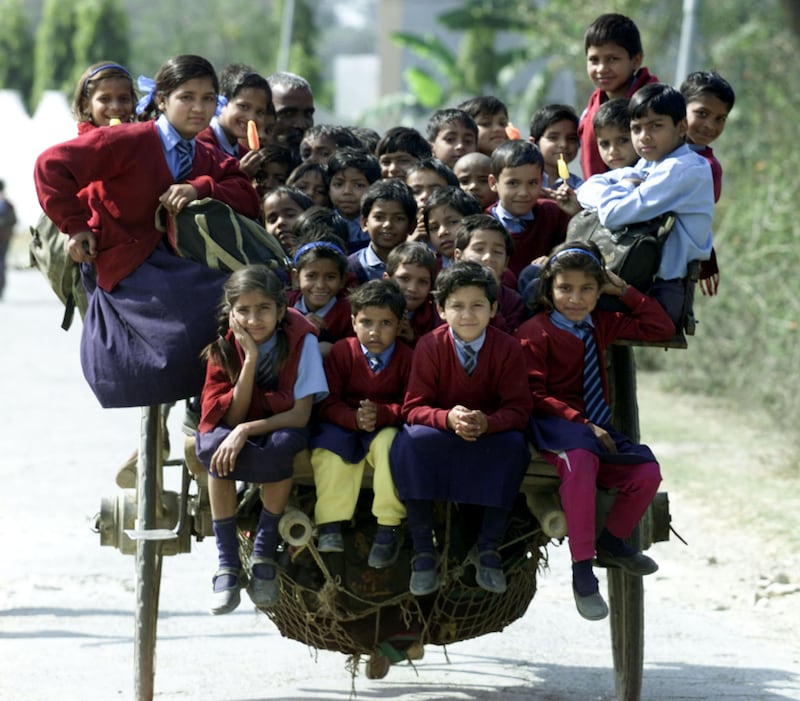
With a population of more than 1.4 billion, India is expected to surpass China in the coming months to become the world’s most populous nation. Reuters
India is likely to become the world’s most populous nation this year, which presents an enormous opportunity for the country's economic growth — provided it can harness the potential of its large workforce , analysts say.
“The country will enjoy an abundant supply of labour and, consequently, should invite even more investments from foreign firms looking to cash-in on India’s growing manufacturing capabilities,” says Raghvendra Nath, managing director of Mumbai-based Ladderup Wealth Management.
“Additionally, rising domestic consumption should help the nation tide over any external shocks, a fact that was well demonstrated during the Covid-19 pandemic.”
With a population of more than 1.4 billion, India is expected to surpass China in the coming months.
S&P Global forecasts that the South Asian country will overtake Germany and Japan to become the world’s third-largest economy by 2030, with annual nominal gross domestic product growth projected to average 6.3 per cent.
Although India is feeling the heat from the global economic slowdown , its GDP is projected by the country’s statistics ministry to grow by 7 per cent in the current financial year to the end of March, making it one of the world’s fastest-growing economies.
Its population in a consumer-driven economy and having what is known as its “demographic dividend” — a large number of young people — will be a major factor in driving its expansion.
In many developed countries workforces are ageing rapidly as population growth slows globally.
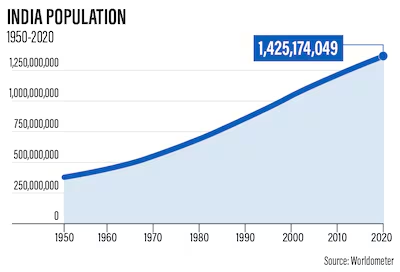
The median age in India is 28.4 years, according to Worldometer. That compares to 38.3 years in the US, 38.4 years in China, and 40.5 years in the UK.
“For India, the main advantage of the young working-age population is that young people adapt fast and can keep pace with the continuing dramatic and constant technological change,” says Vidya Mahambare, professor of economics at the Great Lakes Institute of Management in Chennai.
Saket Gaurav, chairman and managing director of Indian electronics and home appliances brand Elista, says that “India’s large population is one of the most significant opportunities for domestic and international companies.”
It’s “a great growth opportunity for various companies, and especially, for value-driven companies like ours”.
“As a large set of people can produce and consume more goods, it is expected to lead to more economic growth for the country,” says Mr Gaurav. “We consider India’s population as an asset for the business rather than a liability.”
But there is still much work to be done to ensure that India can fully reap the rewards of its large population. Jobs need to be created for the millions of Indians who are joining the workforce each year — and youth need to have the right skills to fill those roles.
The fact that unemployment is on the rise in India is a red flag. Unemployment rose to 8.30 per cent in December, which was its highest level in 16 months, according to data from think tank Centre for Monitoring Indian Economy.
“The drop in labour force participation, along with a high level of unemployment among youth, suggests insufficient job opportunities and skill mismatch,” says Ms Mahambare.
Prime minister Narendra Modi’s government is making efforts to expand the country’s economy and create jobs, for example, through its flagship scheme Make in India, which aims to transform the county into a manufacturing centre.
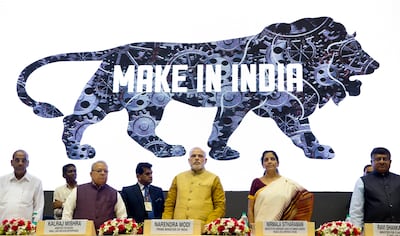
“India is pushing hard to increase manufacturing growth and exports,” says Ms Mahambare.
“The production-linked incentive scheme and other schemes under the Make in India campaign have attracted large-scale electronics, auto components and textile firms, among others. The information technology and emerging biotech and pharma sectors continue to hold good promise.”
At the same time, the government’s Skill India initiative is focused on ensuring that youth are better equipped to meet the needs of companies through measures such as training and partnerships with countries including Japan to co-operate on skill development initiatives.
Only 5 per cent of India’s workforce is formally skilled, despite it being the largest and youngest in the world, according to the World Economic Forum.
“Labour alone cannot take our economy to the next level,” says Poshak Agrawal, co-founder of Athena Education, which helps students to gain admission to highly rated universities through coaching.
“Despite the large population, the country lacks the workforce that is skilled to take up the newly evolved roles,” Mr Agrawal says.
“Recruitment becomes a challenge for various organisations because in Indian colleges, the education is more theory-centric, and there’s a lack of experiential learning.”
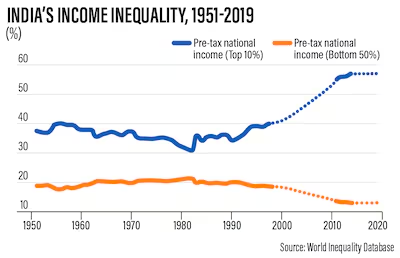
Ensuring that people have the right skills can play a major role in preventing millions of people sliding deeper into poverty, which is an issue that authorities are trying to address.
“I think the policymakers have been gearing towards easing of those challenges to quite an extent,” says Upasna Bhardwaj, senior economist at Mumbai’s Kotak Mahindra Bank.
“If you look at India’s per capita income, it clearly is on the lower side, and that needs to be ramped up.”
India’s GDP per capita in 2021 stood at $2,256, according to the World Bank.
But there are also encouraging signs from the “policy push that we’re seeing … we look at the government’s push towards digitisation, we look at government’s push towards improvising the manufacturing base of the country,” says Ms Bhardwaj.
However, such moves will not yield results overnight, she says.
India’s wealth inequality is a clear challenge and is a situation that could be exacerbated as the country’s population continues to grow. In the financial capital of Mumbai, high-rise luxury flats and expensive restaurants sit alongside slums, with families of some 10 people often crammed into rickety, single-room homes.
Wealth inequality has grown in India in recent decades, and the top 10 per cent of the population hold more than 60 per cent of the country’s total wealth, figures from the World Inequality Database show. The lower 50 per cent of India have just 6 per cent of the nation’s wealth.
“One of the biggest drawbacks of having a growing population is its negative impact on the per capita income and its growth,” says Mr Nath.
“Efforts will have to be made to uplift the weaker sections of the Indian society by improving literacy rates, providing access to quality health care and ensuring that they have easy access to financial services.”
He says that “if these measures fall short of the required levels, we could have a widening wealth gap that could threaten India’s growth story, reducing the country’s chances of becoming the third-largest economy by 2030”.
“Although [having 1.4 billion people] is beneficial for the nation’s economic growth, harnessing its full potential is a significant challenge,” says Rashid Ali, managing director of digital payments solutions company Ezeepay.
However, overall, the large population is an enormous opportunity for businesses like Ezeepay, which is focused on rural areas of India, where the majority of the country’s citizens still live, he adds.
“India’s large population provides many opportunities for businesses to capitalise on, given its vast consumer base. The rural youth population accounts for more than 65 per cent of the total population,” Mr Ali says. In turn, “we have actively generated employment opportunities, especially for the rural population”.
“The anticipated population bulge has produced a demographic dividend, providing an unprecedented chance for economic development,” he adds.
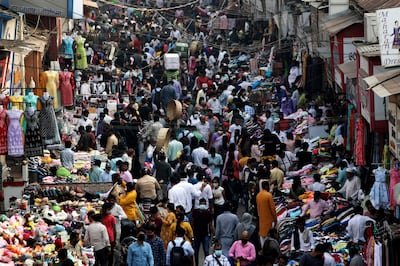
Energy This Week
Expert analysis on oil & gas renewables and clean energy

The Indian Population essay
The world’s most dilemma is the day by day struggle for survival and the scarcity of resources due to increase population. Over six billion people are estimated in the world population today and this increase in number cannot be prevented because of high rate of fertility and the low rate of mortality. This means that more babies are being born than people dying. India is one of the countries considered as mere contributing factors of the growing population. It is the country of high population growth and having more than one billion people.
Because of its unstoppable increase in number, many Indians are suffering in the state of poverty. Most of them are deprived and exploited. This exploitation will bring forth further devastation of the country’s resources. This immediate concern on economic condition and the depletion of resources matters on the availability of the resources, the energy consumption and production capacity. Thus, population growth is sometimes thought to be a resort of the country’s development but in the contrary, this becomes a burden to the public and to the government if not backed up by good policies and programs.
Large population means large consumer group but can also be translated to large purchasing power and large work force that is essential in an economy. In this paper, we will try to examine the current situation of the Indian population. We will also try to identify problems that surround the Indian population and take a look at the means the government of India did in order to solve perceived problems. CURRENT STATES OF AFFAIRS India has more than 1 billion people and approximately 16. 7% of the world’s population.
There are estimated 324 people in every square kilometer. In age structures: “0-14 years 31.7% (male 173,869,856; female 164,003,915); 15- 64 years, 63. 5% (male 349,785,804; female 326,289,402); 65 years and over, 4. 8% (male 25,885,725; female 25,235,905) (2004 estimate)” (http://www. iloveindia. com/population-of-india/index. html). The growth rate in population is estimated to be 1. 44% as of the year 2004. Like most countries, the birth rate in India is higher than the death rate. In every 1000 people in India, 22. 8 births and only 8. 30 deaths are reported. Furthermore, there are only 57. 92 deaths reported in every 1000 live births which is a big imbalance.
Related essays:
- NORWEGIAN SCHOOL OF ECONOMICS essay
- Urban and Rural Inequalities in India essay
- Education for Aboriginals essay
- Homeless Mentally Ill Individuals Share How They See Their Future in essay
The life expectancy in India is 63.99 years for the whole population. Females are said to have higher life expectancy than men. Every woman is equated with 2. 85 children which is extremely high compared to other countries. It was also reported in India as of the year 2001 that 3. 97 million of its population is infected with the deadly HIV disease and there were already 310,000 people who died because of the said sickness. Again, poor sanitation, poor lifestyle and lack of knowledge were some of the perceived reasons in high number of HIV cases and the high number of deaths. “There are three ethnic groups in India.
Among its people, 72% are Indo-Aryan, 25% are Dravidian and 3% are Mongoloids and others” (http://www. iloveindia. com/population-of-india/index. html). Regarding its literacy rate which is defined by 15 and over years of age that can read and write, it was reported that 59. 5% is literate among the total population. Among males, literacy rate is 70. 2% and among women is 48. 3% as of 2003. The figure also implies that men is likely to have education than women. Given the reported figures above, the Republic of India is basically faced with the problem of population control.
Facing the problem of high population rate also tells us that it is also facing the problems given by high population. With this regard, the Indian Government has a very rigorous and difficult job. MEANS TO END THE POPULATION PROBLEM The burden in finding solution to India’s population explosion resides mainly on its own government. In its quest to find answers in controlling population rate increase, the government made measures to solve the problem. These measures are the ones we will discuss further in this paper. In terms of legislation, Government of India passed the Child Marriage Restraint Act in 1976.
To put muscle on the government’s quest for solution in high population increase, mandated was the “strict enforcement of Child Marriage Restraint Act, 1976” (http://populationcommission. nic. in/npp_fun. htm#prom). Child marriage was not only discouraged by the Indian government but also made it a legislation in order to emphasize its importance. There is indeed a need for the Indian government to act now in dealing with population problem. “A cash incentive of Rs. 500 is awarded to mothers who have their first child after 19 years of age, for birth of the first or second child only” (http://populationcommission.
nic. in/npp_fun. htm#prom). The Indian government is indeed serious in their quest to halt population high rate increase. They even spend money for rewards to people who does not get pregnant in an early age. Facilities for safe abortion were also strengthened in India to further address population growth. This is quiet unconventional but practical means in order to fight high population growth which has been a very hard enemy. High population results to high poverty rate in most cases such as in India.
The Indian government is not only facing population problem but also the status of many Indians living below poverty line. Many of these Indians below poverty line do not also have the benefit of what a person coming from a rich family will experience in terms of health care and education. To address this problem, the Indian government also made measures in addressing health care “couples below the poverty line, who undergo sterilization with not more than two living children, would become eligible (along with children) for health insurance (for hospitalization) not exceeding Rs.
5000, and a personal accident insurance cover for the spouse undergoing sterilization. ” Making a person infertile is also part of the huge campaign against population high increase level in the Republic of India. To also address the problem of poverty, the government of India “increased vocational training schemes for girls leading to self-employment will be encouraged” (http://populationcommission. nic. in/npp_fun. htm#prom). To be employed is very much needed and it is of big help to people living below the poverty line especially when they are raising children.
Beyond being employed, it is also the aim of trainings to empower women in terms of their capacity and role in the society which is a very important aspect of the well- being of a woman not only in India but in women from different parts of the world. Women empowerment is one essential part in order for a country to succeed and to be strong. Society is not about men alone, it is between the teamwork of men and women empowered and ready to face the challenges of today’s time.
The Controversy Over a New Population Study From India

A working paper from an independent body that gives economic advice to the Indian government has published controversial findings that critics say could sow communal discord between Hindus and Muslims during the ongoing parliamentary elections.
The paper , titled “Share of religious minorities: A cross-country analysis,” was published on May 7 by the Economic Advisory Council to the Prime Minister (EAC-PM). It found that between 1950 and 2015, India’s Hindu population declined by 7.82%, while the Muslim population increased by 43.15% at the same time. Currently, Hindus make up nearly 80% of India’s 1.4 billion population, while Muslims make up 14%, according to Pew Research Center data from 2021.
Read More: How India’s Record-Breaking Population Will Shape the World
The EAC-PM paper also found that the share of other religious minorities like Christians and Buddhists (but excluding Parsis and Jains) rose by up to 6.58% in the 65-year timeframe.
Authored by experts Shamika Ravi, Abraham Jose, and Apurv Kumar Mishra, the paper aimed to look at how religious composition has evolved across the globe over the past several decades. Using population data from 167 countries, it concluded that there was a dip in the majority religious population not only across India but also notably in Europe. Within South Asia—in countries like India, Pakistan, Bangladesh, Afghanistan, Nepal, Sri Lanka, Bhutan, and the Maldives—it found that the share of the majority religious denomination had decreased in four countries and increased in five.
The study also stated that it was “agnostic to the underlying causes of such demographic change,” concluding that “minorities are not just protected but thriving in India”—an observation that stands in stark contrast to concerns raised over India’s religious freedom in recent years by international human rights groups and the U.S. Department of Justice.
Many Indian news outlets have reported the study’s findings verbatim: “Study Shows India’s Hindu Population Shrank By 7.8%, Busts 3 Liberal Lies,” stated one report by News18. Members of the ruling Bharatiya Janata Party have also been quick to link its claims to the Congress Party, which ruled over India for nearly 50 years following its independence from British rule in 1947, by accusing the opposition of appeasing minorities. “Share of Hindus shrunk 7.8% between 1950 and 2015. The Muslim population grew by 43%. This is what decades of Congress rule did to us. Left to them, there would be no country for Hindus,” Amit Malviya, a prominent BJP member, posted on X . Other BJP members and ministers have also raised concerns about the Muslim community in India allegedly increasing its population to “alter” the demography of India.
In response to the study, the Population Foundation of India (PFI), an independent think tank working on population trends, released a statement on Friday, May 10, calling the EAC-PM findings misleading and alarmist, adding that it was “deeply concerned about the recent media reports that are misreporting the findings…to spread alarm regarding the growth of the Muslim population.”
PFI pointed to the findings from the last nationwide Census in India, conducted in 2011, which found that the decadal growth rate for Muslims had declined over the past three decades, decreasing from 32.9% in 1981-1991 to 24.6% in 2001-2011. In contrast, the growth rate for Hindus fell from 22.7% to 16.8% over the same period.
“Such interpretations are not only inaccurate but also misleading and baseless,” the PFI said of the EAC-PM report.
Read More: What to Know About India’s 2024 Election
As India wraps up the third phase of a grueling six-week election, the timing of the study’s publication has raised eyebrows among critics and demographic experts at a time when the BJP is seen to be openly campaigning on anti-Muslim rhetoric. During a public rally on April 21, Indian Prime Minister Narendra Modi referred to Muslims as "infiltrators” and “those who have more children.” On another occasion, he warned that the opposition would redistribute the property, land, and gold belonging to Hindus among Muslims.
Referring to these instances, the Independent Panel for Monitoring Indian Elections, made up of international experts from India, Europe, and Bangladesh to monitor India’s elections, said that senior BJP leaders were “systematically seeking votes in the name of religion” and “often inciting hate against minorities” in an election bulletin published last month.
More Must-Reads From TIME
- Putin’s Enemies Are Struggling to Unite
- Women Say They Were Pressured Into Long-Term Birth Control
- What Student Photojournalists Saw at the Campus Protests
- Scientists Are Finding Out Just How Toxic Your Stuff Is
- Boredom Makes Us Human
- John Mulaney Has What Late Night Needs
- The 100 Most Influential People of 2024
- Want Weekly Recs on What to Watch, Read, and More? Sign Up for Worth Your Time
Write to Astha Rajvanshi at [email protected]

- WEB STORIES New
- ENTERTAINMENT
- CAREER & CAMPUS
- INFOGRAPHICS
- ISL 2023-24

- Manorama Online
- Manorama News TV
- ManoramaMAX
- Radio Mango
- Subscription

PM Modi doesn't own a house or property, declares assets worth Rs 3 crore
Varanasi: Prime Minister Narendra Modi possesses assets amounting to a little over Rs 3 crore, most of it in bank fixed deposits, according to his election affidavit.
As required, Modi submitted the affidavit while filing his nomination papers Tuesday as an election candidate from the Varanasi parliamentary constituency, a seat he has held twice earlier.
According to the affidavit displayed on the Election Commission website, his movable assets are worth Rs 3,02,06,889. Most of this amount is in the form of fixed deposits with the State Bank of India that total over 2.85 crore.
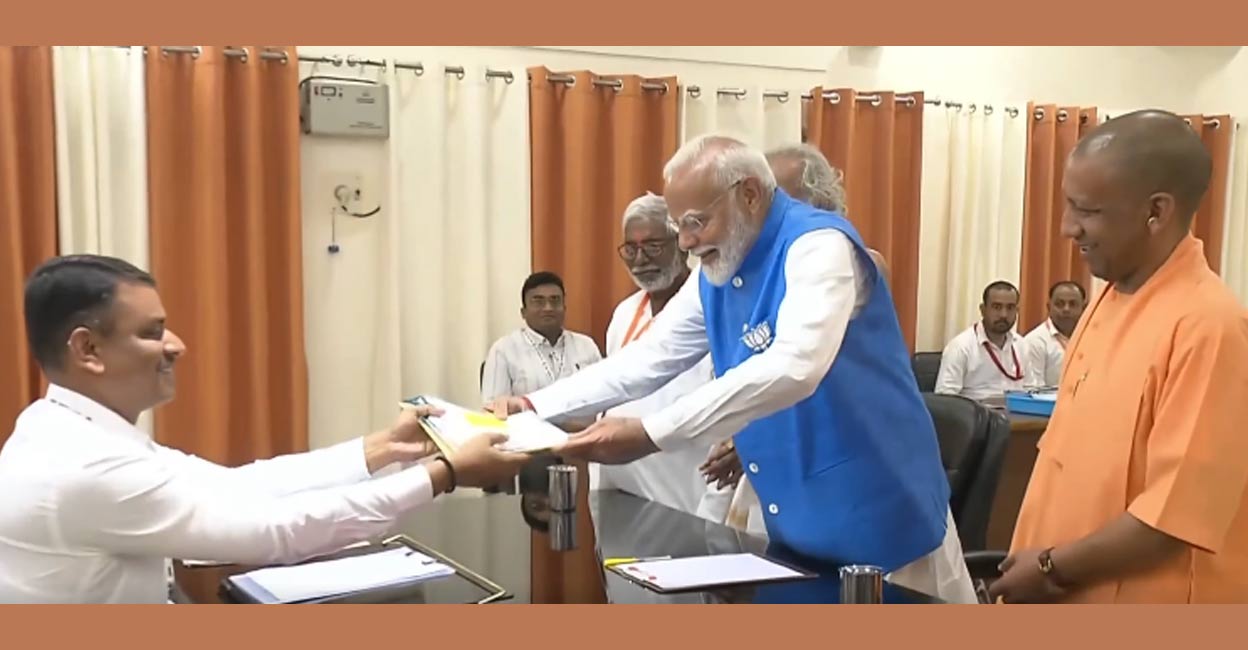
PM Modi files nomination from Varanasi
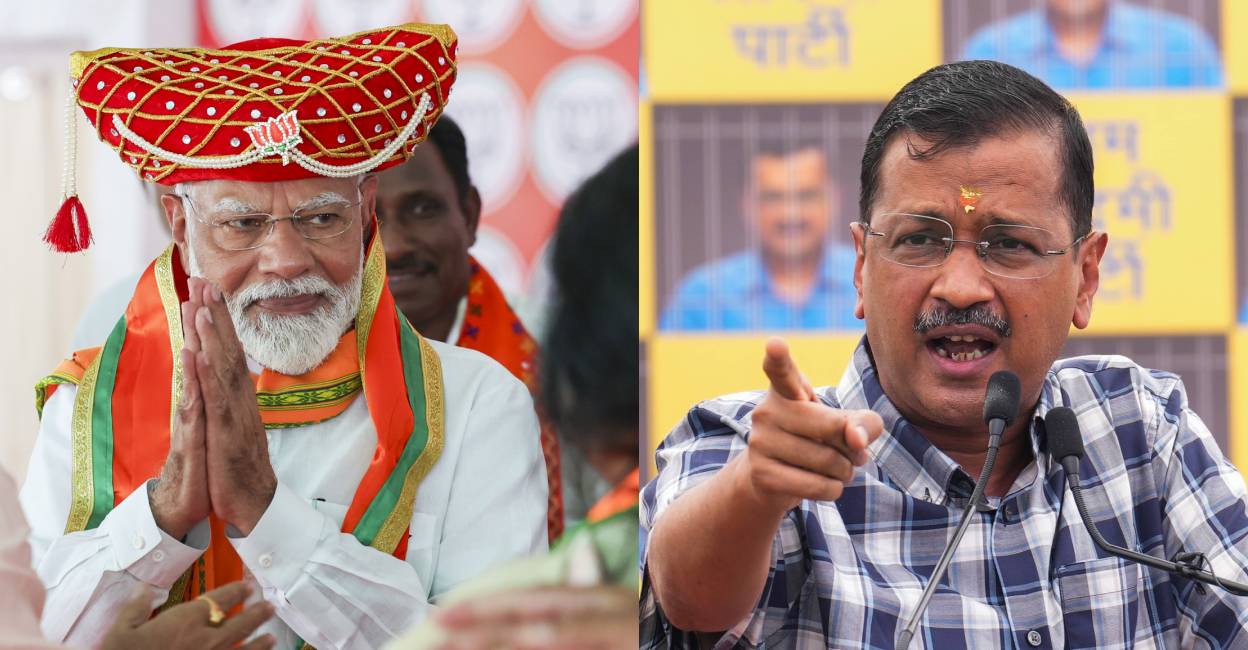
Modi will continue to lead India, BJP on Kejriwal's retirement jibe at PM
Other assets include four gold rings weighing 45 grams valued at Rs 2.67 lakh, cash in hand totalling Rs 52,920, National Savings Certificates worth Rs 9.12 lakh and income tax deduction of Rs 3.33 lakh for the past financial year.
Under immovable assets, the affidavit says "Nil". Typically, land and houses fall under this category. Jashodaben is mentioned as Modi's spouse. On assets held by her, the document says "Not known". The two live apart.
No criminal case is pending against Modi, nor has he been convicted of any crime, according to the document. There are no liabilities due to the government.
The prime minister is described as a resident of Ahmedabad, and his profession as public life and political activity.
He did his SSC in 1967, got a BA degree from Delhi University in 1978 and an MA from Gujarat University in 1983.
In the 2019 Lok Sabha elections, Modi had declared assets worth Rs 2.5 crore including a residential plot in Gujarat's Gandhinagar, fixed deposits of Rs 1.27 crore and Rs 38,750 cash in hand. In the 2014 Lok Sabha elections, he disclosed total assets of Rs 1.65 crore.
The PM has a website and is on Facebook, microblogging site X, YouTube, Instagram and WhatsApp, according to the affidavit.
- Narendra Modi
- Lok Sabha Elections

AAP to be named co-accused in excise policy scam: ED tells Delhi HC

Onmanorama Explains | Increase in Muslim population: What's the real story

Explained | United Nations Forum on Forests (UNFF)

Explained | ASEAN-India Trade in Goods Agreement (AITIGA)

HD Revanna released from jail a day after bail in kidnapping case

SC assures Kerala of listing its lawsuit against ceiling on net borrowing before Constitution bench

Patanjali misleading ads: SC reserves order on contempt notice issued to Ramdev, aide Balkrishna

IMAGES
VIDEO
COMMENTS
India population crisis. India faces a major population crisis due to the growing population. If we were to estimate, we can say that almost 17% of the population of the world lives in India alone. India ranks second in the list of most populated countries. Furthermore, India is also one of the countries with low literacy rates. This factor ...
Essay # 2. Aspects of Population in India: Size and Growth: The current population of India is 1,342,528,871 (1.34 billion) people and it is the second most populous country in the world, while China is on the top with over 1,415,489,506 (1.41 billion) people. Out of the world's 7 billion people, India represents almost 17.85% of the world ...
Learn about Population Essay topic of English in details explained by subject experts on vedantu.com. Register free for online tutoring session to clear your doubts. ... The current population of India is around 140 crores. According to certain reports, in the next few years, there will be a solid growth of population in India, and globally too
China, too, has more than 1.4 billion people, but while China's population is declining, India's continues to grow. Under the UN's " medium variant " projection, a middle-of-the-road estimate, India's population will surpass 1.5 billion people by the end of this decade and will continue to slowly increase until 2064, when it will ...
India has overtaken China to become the world's most populous nation, according to recent estimates. As reported by Bloomberg, at the end of 2022, India's population stood at 1.417 billion ...
In fact, India's population is so large that it will drive much of the expected increase in global population between now and mid-century. When the world hits 9 billion sometime around 2037, 1.6 billion people will be Indian. But the age structure of India's population is drastically changing. The India of 25 years from now is fairly certain.
It put India's population at 1.41 billion in 2022, compared to China's 1.43 billion for the same year. By 2050, India is projected to have a population of 1.67 billion, higher than the 1.32 ...
Ageing population: Due to an increase in life expectancy, India's population is ageing. This has increased the percentage of the elderly populace. for example, in 2011, Kerala's share of the populace over 60 years old was 12.6% and Tamil Nadu's was 10.4%. By 2031, these are anticipated to rise to 20.9% and 18.2%, respectively.
In this essay, I will argue that India's population growth presents complex issues but also holds the potential for economic and social development. The Magnitude of India's Population Growth. India's population has been steadily increasing for decades. It is currently the second-most populous country in the world, with over 1.3 billion ...
There are 7.7 billion people on the earth, and India, with 1.3 billion people, is the second-most populous country after China. Mumbai, the Bollywood capital, is India's most populous city, with a population of 12 billion people. Delhi, India's most populous city, comes in second with 11 billion inhabitants.
500+ Words Population Explosion Essay. Population explosion means a sudden increase in the number of individuals in a particular species. The term is used to refer to the world's human population. In India, the Population explosion has become a severe matter of concern because the increase in population leads to poverty and illiteracy.
Essay on Population Explosion. After the Republic of China, India is the most populous country in the world. Presently, India is the second-largest populated country in the world that occupies 2.4% of the world's land area and represents 17.5% of the world's population. This means that one out of six people on this planet is an Indian.
Introduction. India, the second most populous country in the world, is experiencing significant population growth. With over 1.3 billion people, the demographic changes in India are influencing its social, economic, and environmental dynamics. This essay explores the causes, implications, and potential solutions to the population growth in India.
Population Issue in India: 200 Words Essay on Population. The population of India is currently over 1.3 billion. This number is expected to grow to 1.7 billion by 2050. India is the second most populous country in the world, behind only China. The population growth rate in India is about 1.2% per year.
Population Growth: The UN World Population Prospects (WPP), 2022, forecasts India becoming the most populous country by 2023, surpassing China, with a 140 crore population. India currently has 17.5% of the world's population. This is four times the population India had at the time of Independence in 1947 (34 crore).
Population Essay - Population refers to the total number of people living in a specific area or country. A population is the total number of people living in a particular area. ... India, with a population of over 1.3 billion, is facing the consequences of overpopulation. The rapid population growth has put a strain on resources, resulting in ...
With a population of more than 1.4 billion, India is expected to surpass China in the coming months.. S&P Global forecasts that the South Asian country will overtake Germany and Japan to become the world's third-largest economy by 2030, with annual nominal gross domestic product growth projected to average 6.3 per cent.
The report stated that in the year 2019, India has an estimated population of 1.37 billion and China, 1.43 billion and by the year 2027, India's population is projected to surpass China's, making India the most populous nation in the world. 30 years down the line, the global population is projected to increase by another 2 billion people by ...
Over-population has been major problem in India. The efforts to remove the curse of population problem have only been partially effective. In consequence the rate of population increase has gone down, but the balance between the optimum population growth and a healthy nation is far to be achieved. ... Essay on Population Problem in India ...
The essay will consist of the history of the American Indian population, current statistics, news within the last six months pertaining to the population, and links and resources will be provided. The class textbook, Strangers to These Shores 11th Edition by Vincent N. Parrillo, is the main resource utilized for historical information on the ...
The growth rate in population is estimated to be 1. 44% as of the year 2004. Like most countries, the birth rate in India is higher than the death rate. In every 1000 people in India, 22. 8 births and only 8. 30 deaths are reported. Furthermore, there are only 57. 92 deaths reported in every 1000 live births which is a big imbalance.
It found that between 1950 and 2015, India's Hindu population declined by 7.82%, while the Muslim population increased by 43.15% at the same time. Currently, Hindus make up nearly 80% of India ...
According to the affidavit displayed on the Election Commission website, his movable assets are worth Rs 3,02,06,889. Most of this amount is in the form of fixed deposits with the State Bank of India that total over 2.85 crore. Other assets include four gold rings weighing 45 grams valued at Rs 2.67 lakh, cash in hand totalling Rs 52,920 ...